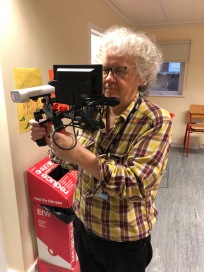See Link
Towards hMoMA Research – Portable Volumetric Video Capture and Display Accomplished
Project Status – April 6 2020
I am delighted to report the completion of the contract I made with PlayLab.Z to update their fixed studio volumetric capture and display rig at Ravensbourne University London to a portable multi camera system using the latest immersive technology. This is a project I specified and funded.
Early testing GenieMo and GenieMo Flow at Ravensbourne University featuring myself with James Edward Marks and Prof David Crawford walking on the moon. Two Azure Kinect Rig.
At my request, in order to gain contract completion sign off, PlayLab.Z successfully set up and demonstrated the system at a UAL Digital Maker Collective (DMC) event at UAL Camberwell College of Arts on on 12 February 2020.
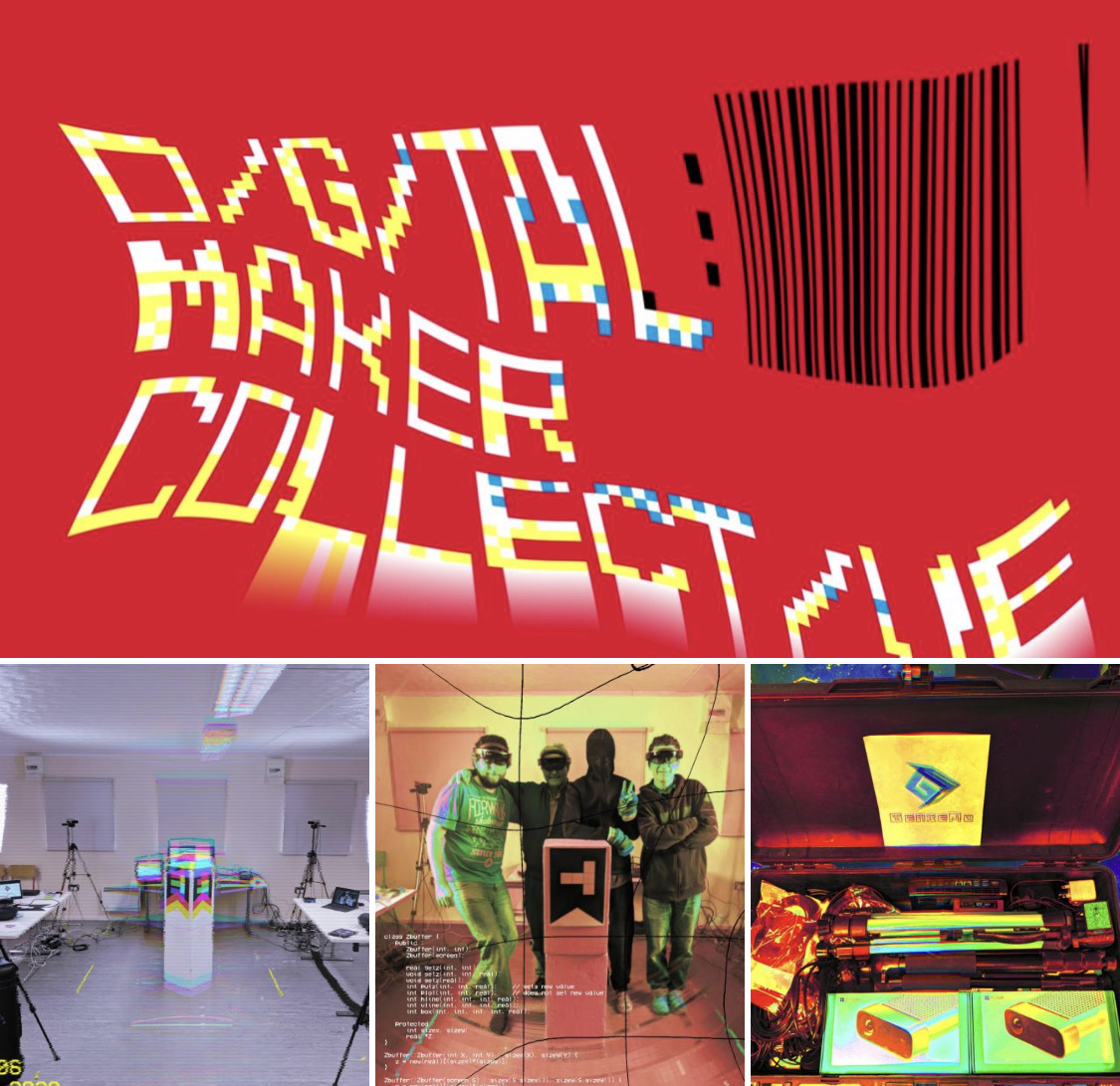
UAL Digital Maker Collective demonstration of Portable Volumetric Video Capture Rig. 4 Azure Kinect System. I am second on the left.
A user manual with a Github link was provided shortly after.
PlayLab.Z was then invited to participate in UAL DMC Tate Exchange 2020, Tate Modern during week commencing 2 March 2020 and the system was formally launched as GenieMo (capture) and GenieMo Flow (display) at Jisc DigiFest Birmingham 2020 on 9/10 March 2020.
My wife Suzy Aitchison at UAL DMC 2020 Tate Exchange, Tate Modern. Two Azure Kinect camera system with Looking Glass Factory Display.
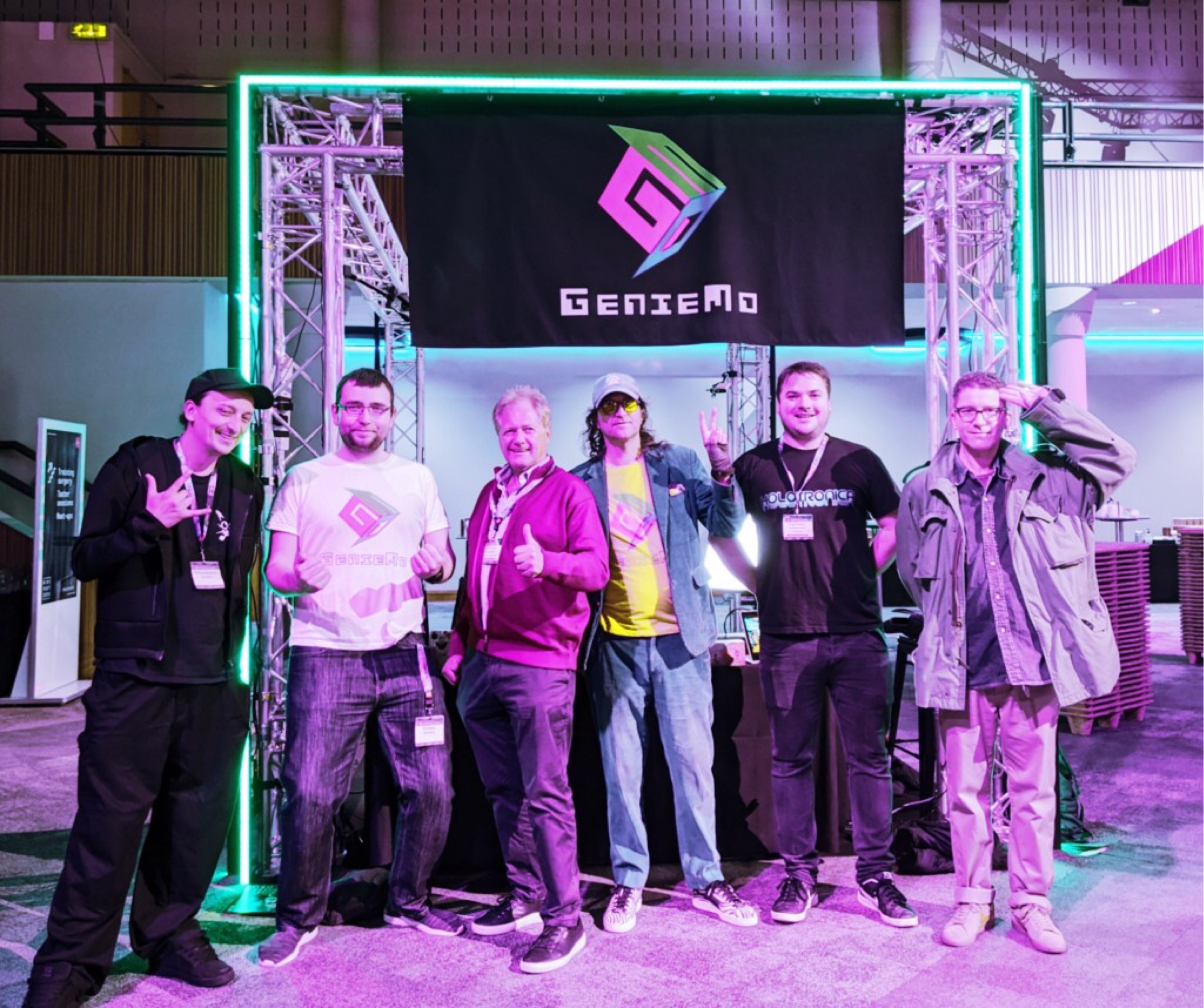
PlayLab.Z team with Holotronica at Jisk DigiFest 2020. Myself with thumbs up and Lee Robinson on end saluting
The launch at Jisc DigiFest 2020 was co-produced with Holotronica. GenieMo deployed two Microsoft Azure Kinect cameras (although at UAL it was demonstrated with four), Intel NUC Microcomputers, and a high performance external graphics processor (NVIDIA GTX 2080). GenieMo Flow was demonstrated showing captures in real-time with Microsoft HoloLens 1, a Looking Glass Factory volumetric display screen, and on a giant Holotronica transparent screen in the exhibition auditorium.
I am the Genie in the lamp! Holotronica display at Jisc DigiFest 2020. Volumetric capture with two Azure Kinects
I participated in all the above events and at the time of writing this post I am now at home in self-isolation during the Covid 19 (Coronavirus) pandemic.
Observations
What has been achieved and demonstrated is a massive achievement, especially in the timescale and with limited resources. It provides considerably less expensive tools for students to experiment and learn about volumetric film-making and to make associated media art in their educational settings.
PlayLab.Z are now extending their involvement independently beyond education establishments using their software (and currently mostly my hardware -on loan) to promote multi dimensional art for social good.
However, in relation to my own research, more progress needs to be made before the technology meets the exacting installation ease and fidelity requirements of a museum or art institution. This is what I will report on next as I have an extensive collection of the latest research papers and information on emerging technology, which as far as possible I am acquiring and deploying in my practice based research. This is what I am targeting but as a portable system without a green screen and 4-8 cameras. All Kinds of Limbo was recorded at Dimension Studio Wimbledon using the Microsoft licenced Volumetric Capture System.
Towards hMoMA Research and PhD Update
It has been over a year since my last post and a lot has happened, so its time for an update. I will now post on a frequent basis as it will evidence work I am undertaking towards my PhD ‘Making the absent object present: Towards hMoMA, a holographic Museum of Modern Art’.
My Azure Kinect handheld volumetric filming rig developed at University of the Arts Digital Maker Collective
PhD update
In January 2019, after a term into my PhD at Kingston School of Art, Kingston University London my PhD supervisors and I concluded that the initial stage of my practice based research was heavily immersive technology focused and outside the competencies of the academic staff of the University. I agreed to suspend my PhD until this first phase was completed independently and I had a museum partner where the technology could be deployed.
I intend rejoining my PhD at Kingston in October 2020 or January 2021 when this research can be deployed in a major museum. Independent research can be submitted as Prior Learning for a PhD which shortens the time for its completion. This blog and my posts on Research Gate https://www.researchgate.net/profile/Terence_Quinn2 will document my practice based technology research and my art practice which incorporates this technology.
Independent Immersive Technology Research
Collaborating Universities and Institutions
University of the Arts London where I am now a visiting practitioner and working with the UAL Digital Maker Collective led by Chris Follows, Emerging Technologies Manager for UAL Camberwell, Chelsea & Wimbledon Colleges of Arts.
Ravensbourne University London (RAVE) where I am collaborating with their research department led by Research Director Dr Nick Lambert, and Senior Research Fellow Carl Smith.
PlayLab.Z an independent RAVE embedded immersive technology practice (formerly the development team for DoubleMe HoloPortal Lab) supported by Prof. David Crawford (also of Kent University and Director of Futures Zone at IBC Media, Entertainment and Technology Show, Amsterdam). PlayLab.Z is a Community Interest Company (CIC) with director/developers James Edward Marks, RAVE alumni Marius Matesan, Chris Szkoda and Phil Tidy, owner/executive producer of Squire Studio London. I am currently pioneering with PlayLab.Z to further develop the technology originally produced by them for DoubleMe. My role is systems architect and provider of the resources and equipment necessary for the development.
Original Outcomes
This practice based research is pioneering the development of immersive technology for deployment in education, museums and art institutions. It’s ultimate aim is to replace current in-house museum collection digitisation and display practice with portable technology that will:
- Dramatically speed up the digitisation process. Currently collections of hundreds of thousands if not millions of artefacts take decades to volumetrically capture or photograph
- Allow digital copies of collections to be viewed at original scale on demand in mixed or virtual reality as though they are physically present. Digital copies are currently viewed as small flat images on computer or hard copy documentation
- Enable stored physical collections to be displayed as life-sized holograms in the museum. Currently 95%+ of collections in 55,000 major museums Worldwide are in storage and rarely if ever displayed. Exhibits in temporary exhibitions are mostly returned to contributors or imported from other national museums. Major museums seek to display their collections regionally rather than just nationally which is difficult if suitable locations have to be found and objects physically transported
- Enable curators to be recorded as video holograms to provide real-time interpretation of combined digital and physical exhibits from around the world
- Link volumetrically digitised collections to museum archives (archives hub). Researchers can then view artefacts on demand and as though physically present in the viewer’s real world environment. Currently, access to stored collections and archives is possible but in highly restrictive circumstances and very limited numbers
- Create digital copies of a museum or art institution’s collection in their own dedicated archive in the Cloud. This will ensure the protection of an institution’s Intellectual Property Rights in their digitised collections as they are only available on the internet at the organisation’s sole discretion. This approach will require the deployment of 5G technology to speed upload and access
An early version for education is to be launched at Jisc DigiFest 2020 in Birmingham on 10/11th March 2020. The software branded GenieMo will be demonstrated each day by PlayLab.Z Ravensbourne University using a recently constructed portable volumetric video capture rig, and GenieMo Flow will display volumetric video in real time on Microsoft HoloLens.
https://www.jisc.ac.uk/digifest#
PlayLab.Z will deploy the code to Github which will be free for experimentation by educators and students. Future releases will work towards the described planned outcomes for museums and galleries.
My art practice continues in parallel and is concerned with immersive storytelling and current social issues. It makes use of the immersive technology now under development with my collaboration partnerships.
During last year 2019 I was fortunate to present and demonstrate my art installation ‘The Refugees’ Crisis’ at a number of prestigious venues including Somerset House, and for the Creative Conscience Awards 2019 for which it won Gold in the Experience category https://www.creative-conscience.org.uk/winners/terence-quinn/. This work combines a more traditional media installation (film and sculpture) with mixed reality (a holographic refugee was projected many times into the physical exhibit). This was combined with a binaurally recorded narrative in order to increase personal immersion in and empathy towards the Refugees’ Crisis, to hard hitting emotional effect.
The holographic representation of the refugee in this art installation is a work in progress towards the independent technology research I am currently undertaking. I presented this in my presentation at the Computer Arts Society London organised EVA London 2019. This is an internationally recognised academic forum concerned with the Electronic Visualisation of the Arts. For example, Professor Oliver Grau, a World renowned academic in this field presented at an EVA conference in Germany in the same year.
Terence Quinn – PhD Personal Statement – Sept 2018
I am the first person in my extended family to stay at school past age 15. Despite having demonstrated a talent for art, given my early life circumstances, I did not consider art a viable employment option. Instead I pursued a long career in technology, including senior positions in IBM and selling my own software company, which allowed me to retrain and practice as a garden designer.
Whist designing gardens I also attended part-time courses and weekly studio practice in portrait and life drawing, first at Putney School of Art then at the Cheyne Drawing Studio based at the London Sketch Club. During this time, I exhibited at both venues and sold some of my life drawings at the Daggart Gallery, Notting Hill. I also experimented with professional digital photography using the iPhone, taking several part-time courses at Kensington & Chelsea College where a selection of my photographs were exhibited. These experiences kindled my desire to undertake a third career as an artist. I decided to join an art school where utilising my technology background, I could explore the intersection of art and technology. That led to my two-year practice led research MA in Fine Art Digital at UAL Camberwell School of Art and my recent staff appointment as a visiting practitioner. I now focus on storytelling, exploring a mixture of traditional art and the latest technologies.
My ability to add new knowledge in a practice led research PhD is evidenced by:
- A Distinction in my MA. Transcripts include “Overall, your progress on the course has been incredible…Evidence of analysis which potentially contributes new ideas, processes or knowledge to the field or is ground breaking in a way that would be recognised as valid by experts in the field”.
- My final MA Show exhibit, ‘The Refugees’ Crisis’ being the subject of a recent BBC Radio 4 iPM Programme. http://www.bbc.co.uk/programmes/p058pzvh .This artwork breaks fresh ground artistically by incorporating Mixed Reality (MR) into a physical installation. http://blogs.arts.ac.uk/pgcommunity/2017/09/27/the-refugees-crisis/. In February 2018, I exhibited this again and spoke at St. Hugh’s College, Oxford University.
- My PhD research proposal following on directly from my MA research paper (Distinction grade A+), which explores the ‘digital gap’ in our cultural heritage resulting from unresolved issues with the conservation of born-digital art. https://terencemquinn91.org/2016/10/05/research-paper-digital-to-physical-made-to-last-will-functioning-digital-art-be-part-of-our-future-cultural-heritage/. One of the aims of my PhD research is to provide a possible solution.
- Technical research for my PhD building on a long and deep experience in computer technology. Whilst waiting to start a PhD, my research has continued informally. I have exhibited at Tate Modern for Tate Exchange in 2017 and 2018, http://www.tate.org.uk/visit/tate-modern/tate-exchange and at Tate Lates March 2018.
- Regular attendance of the monthly Augmented Reality Forum held at UCL and other events including VR World and Lumen Prize.
- Membership of EVA London (Electronic Visualisation and the Arts) and Volumetric Filmmakers NYCU.
- Consistent visits to art galleries and museums, including Venice Biennale 2017, and the Rijksmuseum and Van Gogh Museum Amsterdam in 2018. I am a friend of RA and Tate.My wife is a member of the Museums Association, and a volunteer in the Theatre and Performance archives of the V&A.
- My own home office with advanced facilities including equipment for 3D scanning, volumetric filmmaking, virtual and mixed reality, binaural audio recording, IoT and photography.
My art practice is concerned with immersive storytelling and current social issues.
I use Mixed Reality (a form of VR allowing 3D virtual objects to be combined with my physical art installations) and binaural audio in order to increase empathic response from the audience. Physical art installations consist of digitally fabricated sculpture set amongst a video background projected on all surrounding walls. Visitors first see this, then use either headphones (with inbuilt audio players) or a Mixed Reality visor, currently the Microsoft HoloLens to experience added layers to the work. These devices allow the user to freely walk around the installation while experiencing actors performing alongside huge-scale 3D replicas of the sculptures, both appearing as part of the physical installation.
I have entered my art installation ‘The Refugees’ Crisis’ for the Aesthetica Art Prize 2018, which if successful would be exhibited in Spring 2019.
Academic and practice based research for my PhD at Kingston University
I plan to submit two papers to EVA London 2019, the first based on my MA research paper concerned with issues relating to the conservation of digital art, and the second a short introduction to my PhD research.
I will investigate the possibility of working with Kingston University Centre for Augmented and Virtual Reality (CAVE), a facility of the Faculty of Science, Engineering and Computing. In particular, I would like to set up a pilot for Volumetric Filmmaking using my own equipment, which if successful KU may wish to expand this to a full capability. This is part of my planned PhD practice based research as it is a portable facility to volumetrically record both static art (paintings and sculpture), as well as movement (art installations and performance) in a museum and art institution setting. This will contribute to an archive that will enable recorded art to be viewed as though it were physically present in a real world environment using Mixed Reality glasses, a glasses free holographic display, or AR projection mapping. Artworks in the collections of other institutions that have been captured in 3D could also be brought into this archive, and viewed in the same way.
I maintained a WordPress Blog for my MA, which I am continuing for my PhD. This can be viewed at www.terencemquinn.com .
I have already established a file of my PhD research on Evernote, with currently over 1300 items including research papers, articles, and books. I can provide access to all or part of this record to my PhD Supervisors if requested. I am in the process of building a detailed Mind Map for my PhD which can also be shared and discussed in order to agree an appropriate programme of research.
Terence Quinn – PhD Research Proposal – Sept 2018
Making the Absent Object Present: Towards a holographic Museum of Modern Art (hMoMA)
Practice Led Research: How artworks can be recorded and viewed in Mixed Reality to enable a holographic Museum of Modern Art (hMoMA).
Mixed Reality (MR) devices now allow 3D 360-degree holograms to appear physically present in the real world. Such devices enable a person to view and walk around a hologram as they would the original, but in their own home or educational environment. Although not the same as viewing the original, the MR hologram provides an alternative experience to the viewer that is very close to reality. My investigations will determine which categories of artwork can be recorded and viewed effectively in MR, and how this may be achieved in a museum or art institution setting.
The primary aim of this research is to enable art institutions to display, in a single gallery space, any recorded object in their collections, or from past temporary exhibitions. This will include artworks otherwise hidden from public view, such as the vast collections now in storage due to limited gallery space, or which are too fragile for public display, or which cannot be conserved for the long-term, such as digital art.
This research will therefore make important contributions to new knowledge for creating a holographic Museum of Modern Art. If implemented, hMoMA will enable present and future generations to experience more of their cultural heritage than is otherwise possible.
Proof of Concept
Delft University in Holland use MR to enhance the visitor experience of a Rijksmuseum exhibit (Maltha, 2016).
“Scan the World is an ambitious initiative whose mission is to archive the world’s sculptures, statues, artworks and any other objects of cultural significance using 3D scanning technologies to produce content suitable for 3D printing”. The British Museum and Tate are contributors to this initiative which currently provides open on-line access to 3D scans of almost 9000 sculptures (MyMiniFactory, 2014).
My research so far, extends these ideas and illustrates some first steps towards achieving hMoMA.
In April 2017, I took part in demonstrating to V&A academics my exhibit Making the absent object present. Wearing a Microsoft HoloLens headset, participants walked around a hologram of my 3D sculpture, displayed in exactly the same place as the removed original (also shown at Tate Exchange: Tate Modern, Kingston University and The Museum of Futures, London).
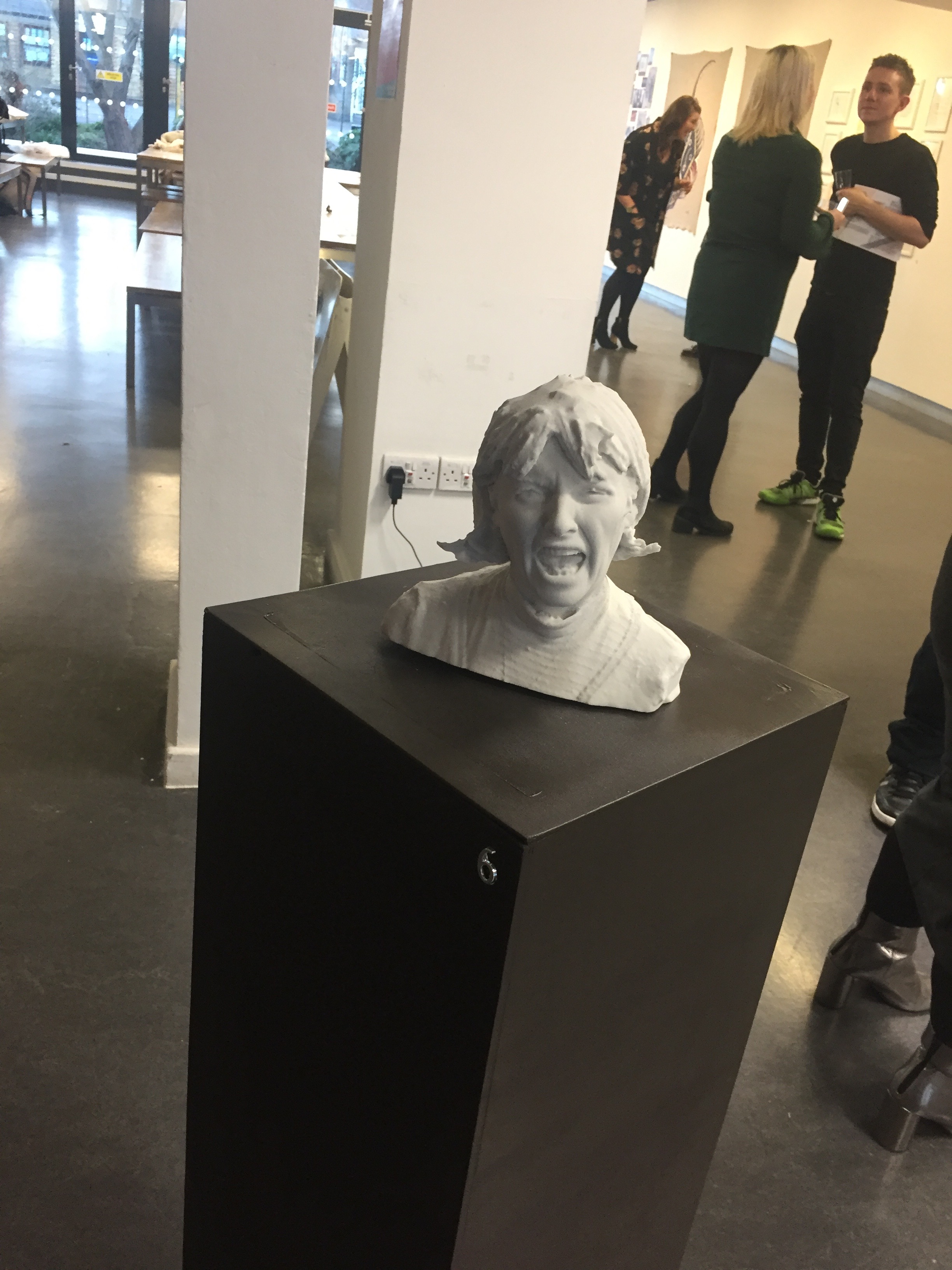
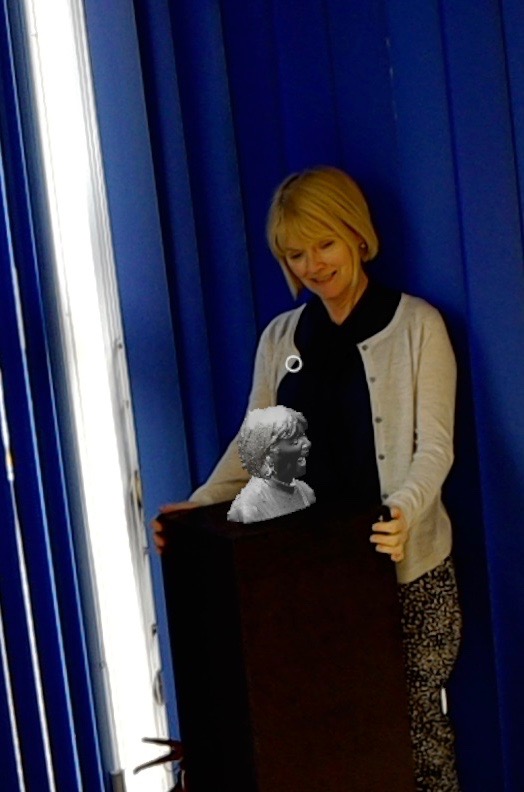
The original sculpture The holographic sculpture
In July 2017, my MA show exhibit The Refugees’ Crisis allowed participants to freely walk around several oversize holographic images as an integral part of a physical art installation, while listening to a binaural recorded narrative. This was the subject of a BBC Radio 4 iPM programme (BBC Radio4 iPM, 2017).
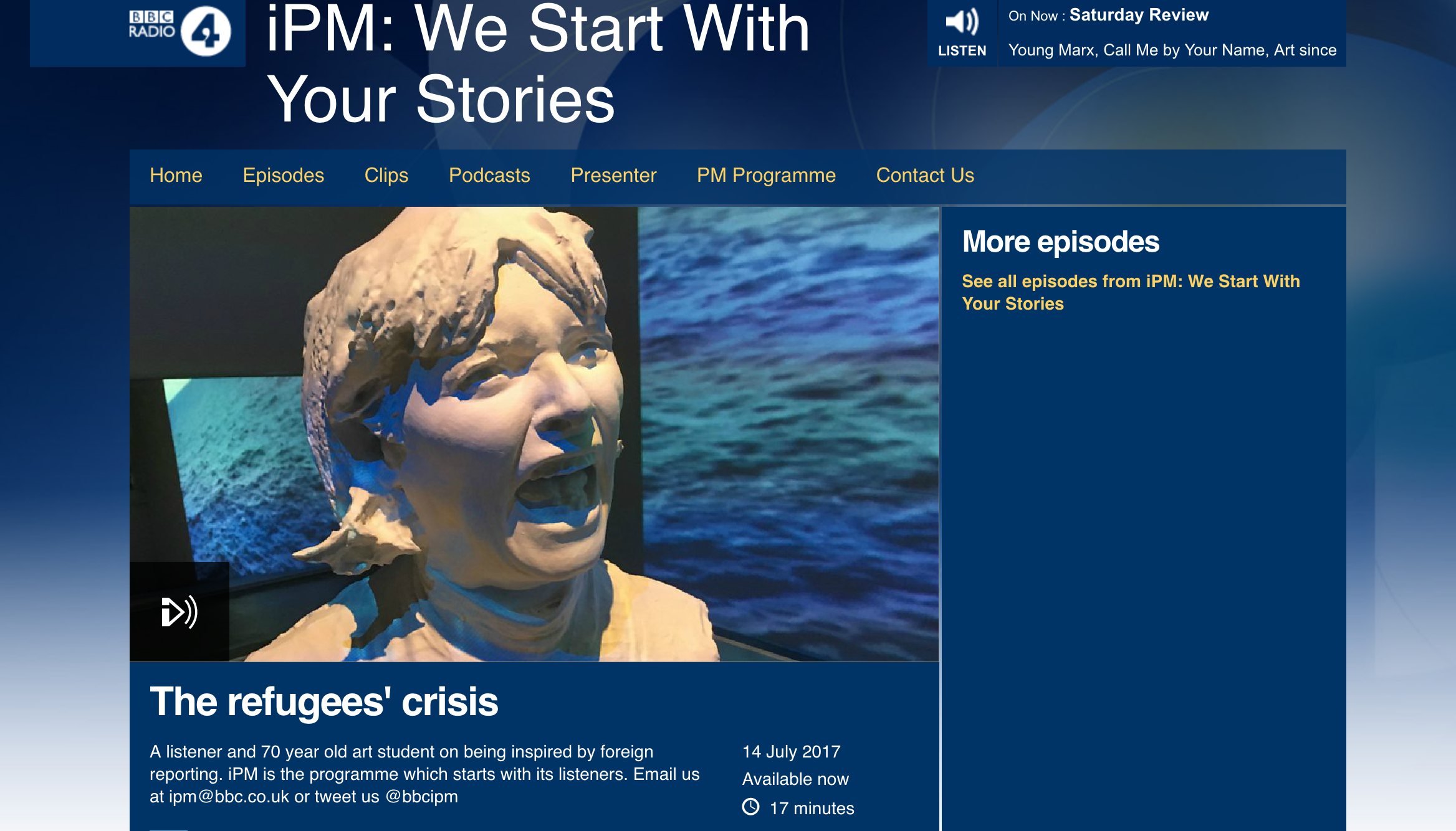
In February 2018, I spoke and exhibited this again at St. Hugh’s College, Oxford University.
The Refugees’ Crisis
Ravensbourne University HoloPortal lab, which is supported by Microsoft and a research organisation (DoubleMe, n.d), have offered the possibility for me to volumetrically re-record the short film in this installation. It will enable the speaking, moving characters to be seen in MR as though they were physically present in my exhibit. However, I first plan to set up and test my own portable Volumetric Filmmaking facility using six RealSense D415 depth sensing cameras, and Realsense SDK.
My PhD builds upon my MA research paper Digital to physical – made to last? Will functioning digital art be part of our future cultural heritage? (Quinn, 2016) which examined the issues involved with the conservation of digital art in the context of our future cultural legacy. Digital art in particular is transitory as most will eventually be lost forever due to decay or technical obsolescence.
The technologies used are expected to develop considerably over the timescale of a PhD, which will give me the opportunity to significantly extend my enquiry. This fast paced development is evidenced by a plethora of recent and expected announcements in the field of Virtual and Mixed Reality from Microsoft, Apple, Google, ODG, Meta and many other advanced technology companies worldwide.
Original Contribution to Knowledge
Most research in the area of VR/ MR is not directed towards artistic endeavor, but to commercial opportunity particularly for gaming or business application.
My research would provide the following contributions to new knowledge, as hMoMA will:
- Make the absent object present and allow users to experience recorded artworks in a way that is very close to seeing the original.
- Make an important new contribution towards providing a record of important artworks for our future cultural legacy.
- Provide an additional advanced form of archival documentation.
- Offer an alternative to conventional digital art conservation.
My research questions and provisional timetable
Year 1
- What types of artwork can be captured to be viewed holographically? By what means? At what quality? To what extent is the authenticity of the original preserved in the outcome? Painting, sculpture, performance art, born-digital art, interactive art and exhibitions all have different requirements.
- How can artworks be captured in their established setting? Artworks exhibited in a museum, in storage or outside have different demands.
- How can captured artworks be experienced in various settings and by what means? In a museum? At home?
- What is the reaction to hMoMA by all stakeholders? Artists, curators, the general public, lawyers, academics?
- What will incentivise stakeholders to actively support or promote hMoMA in their organisation? To overcome potential resistance to change.
- What other potential barriers exist to hMoMA, including cost and copyright law?
- What other contributing developments and research exists in other universities and institutions?
- Finalise my PhD practice based research proposal.
Year 2
- What version(s) of hMoMA can be implemented now? Demonstrate what can be achieved using my own artwork(s).
- Approach the V&A and Tate with a view to a research collaboration. Agree to develop metrics to judge results of an hMoMA prototype using an art installation in their collection. This will provide the basis for reflection and critical analysis of the project.
- How does the practical implementation of hMoMA perform against agreed metrics? Carry out an external demonstration using both my own artwork and that of a collaborating institution.
- What further research and development is needed? Determine how limitations and barriers to hMoMA might be overcome, and provide direction for further research, including what is needed for volume implementation.
Year 3/4
- Publish results as my PhD practice based dissertation.
- Organise, or participate in, a public exhibition showing the best of what can be achieved with hMoMa.
Bibliography
8i. (2015) 8i introduces fully volumetric 3D video. Available at: https://www.youtube.com/watch?v=aO3TAke7_MI [Accessed: 18 October 2017].
Amathys 3D. (2014) Augmented Reality Geneva Art & Museum History Museum Achille et Penthésilée Corps et Esprits. Available at: https://www.youtube.com/watch?v=i0nL8gWblBM [Accessed: 12 October 2017].
Appleyard, B. (2017) The V&A’s History Man: Meet the new boss Tristram Hunt. London, UK. Sunday Times.
Baker, M (1982, revised 2007) The History of the Cast Courts. Available at: http://www.vam.ac.uk/content/articles/t/the-cast-courts/ [Accessed: 30 March 2017].
Barreca, L. (2009) Conservation and documentation of new media art. Available at: https://academiccommons.columbia.edu/catalog/ac:174882 [Accessed: 26 September 2016].
BBC Radio4 iPM. (2017) The Refugees’ Crisis by Terence Quinn. Available at: http://www.bbc.co.uk/programmes/b08xcxh0 [Accessed: 30 July 2017].
Bhaskar, M. (2016) Curation: The power of selection in a world of excess. London, UK. Piaticus Publishing.
Brandi, C. (2010) Theory of Restoration. Available at: http://isites.harvard.edu/fs/docs/icb.topic822683.files/Brandi_Theory%20of%20Restoration%20I_sm.pdf [Accessed: 26 September 2016].
Cameron, F. and Kenderdine, S. (eds.) (2010) Theorising Digital Cultural Heritage: A Critical Discourse. Massachusetts, USA. The MIT Press.
Cameron, F. (2007) ‘Beyond the Cult of the Replicant: Museums and Historical Digital Objects – Traditional Concerns, New Discourses’ in Cameron, F. and Kenderdine, S. (eds.) Theorising Digital Cultural Heritage – A Critical Discourse. Massachusetts, USA. The MIT Press.
Cloonan, M. V. (ed.) (2013) Preserving our heritage. Perspectives from antiquity to the digital age. Chicago, USA. American Library Association.
Cunliffe, E. (2016) Can we 3D re-print the history we have destroyed? Ethics of Restoration. Available at: https://qz.com/656151/can-we-3d-re-print-the-history-weve-destroyed/ [Accessed: 15 April 2017].
Cyark. Digitally Preserving Heritage At-Risk. Available at: http://www.cyark.org/projects/ [Accessed: 20 April 2017].
Delve, J. and Anderson, D. (2014) Preserving complex digital objects. London, United Kingdom. Facet Publishing.
De Vries, J. (2016) HoloLens at the museum: Reflecting on the project. Available at: https://hololens2016.weblog.tudelft.nl/ [Accessed: 30 March 2017]
Digitization Program Office (n.d) Smithsonian X3D. Available at: https://3d.si.edu/ [Accessed: 30 March 2017].
DoubleMe. (n.d) Launch of World’s First HoloPortal at Ravensbourne. Available at: http://www.doubleme.me/#holoportal [Accessed: 23 January 2017].
Esparo, Y. (2016) New York City – Augmented reality art show. Available at: https://www.youtube.com/watch?v=NrzsZSnJGCM [Accessed: 18 October 2017].
Euclidean Holographics. (2017) World’s First Hologram Table. Available at: https://www.youtube.com/watch?v=GjPWk0UhKDQ [Accessed: 18 October 2017]
Factum Arte (2017) What is Factum Arte? Available at: http://www.factum-arte.com/aboutus/ [Accessed: 15 September 2016].
Gayford, M. (2012) Old media, digitized, make new forms. Computers are changing art in unexpected ways. Available at: https://www.technologyreview.com/s/429643/old-media-digitized-make-new-forms/ [Accessed: 26 September 2016].
Hazan, S. (2007) ‘A Crisis of Authority: New Lamps for Old’ in Cameron, F. and Kenderdine, S. (eds.) Theorising Digital Cultural Heritage – A Critical Discourse. Massachusetts, USA. The MIT Press.
Kipman, A. (TED 2016) A Futuristic Vision of the age of holograms. Available at:
https://www.ted.com/talks/alex_kipman_the_dawn_of_the_age_of_holograms [Accessed: 10 January 2017].
Lo, R. (2016) Microsoft Hololens Newest Competitor: Meta 2 (and it might be even better). Available at: https://www.youtube.com/watch?v=jHHa1BNCDcA [Accessed: 20 January 2017]
Lozano-Hemmer, R. (2015) Best practices for conservation of media art. Available at: https://github.com/antimodular/best-practices-for-conservation-of-media-art [Accessed: 26 September 2016].
Mackie, J. (2016) ODG 4K Augmented Reality Review: better than HoloLens? Available at: http://www.youtube.com/watch?v=xVhF3ai44Xo [Accessed: 20 January 2017].
Maltha, A. (2016) Demo HoloLens Temple Experience – TU Delft. Available at: https://vimeo.com/190609328 [Accessed: 12 January 2017].
MacLean, M. and Davis, B. (eds.) (2000) Time and bits: Managing digital continuity. Los Angeles, USA. Getty Research Institute.
Meyrick, M. (2013) BBC Frozen Planet Augmented Reality – created by INDE. Available at: https://www.youtube.com/watch?v=fv71Pe9kTU0 [Accessed 21 October 2017]
Microsoft. (2016) Hololens: Pushing the limits of storytelling. Available at: https://www.microsoft.com/microsoft-hololens/en-us [Accessed: 26 September 2016].
Microsoft. (2016) How Microsoft records Holographic video content for the HoloLens. Available at: https://www.youtube.com/watch?v=kZ-XZIV-o8s [Accessed: 10 August 2016].
Microsoft. (2016) Microsoft HoloLens: HoloTour. Available at: https://www.youtube.com/watch?v=pLd9WPlaMpY [Accessed 12 February 2017].
Microsoft. (2015) How Microsoft records Holographic video content for the HoloLens. Available at: https://www.youtube.com/watch?v=kZ-XZIV-o8s [Accessed: 15 August 2016].
Mongeon, B. (2016) 3D Technology in Fine Art and Craft. New York, USA. Focal Press.
Michel, B. (2013) Digital Stereoscopy: Screen to Screen 3D Production Workflow. Sprimont, Belgium. Stereoscopy News.
MyMiniFactory. (2014) MyMiniFactory: Scan the World. Available at: https://www.myminifactory.com/scantheworld/ [Accessed: 18 August 2016].
Petrelli, D. (2016) Material Encounters with Digital Cultural Heritage. Available at: http://www.mesch-project.eu/outputs-3/ [Accessed: 30 April 2017].
Quinn, T. (2016) Digital to physical – made to last? Available at: https://terencemquinn91.org/2016/10/05/research-paper-digital-to-physical-made-to-last-will-functioning-digital-art-be-part-of-our-future-cultural-heritage/ [Accessed: 20 October 2017].
Richardson, R. (2016) The Arch of Triumph of Palmyra is recreated in London – 1,800 years after it was built. Available at: http://www.telegraph.co.uk/news/2016/04/08/why-the-arch-of-triumph-of-palmyra-is-being-recreated-in-london/ [Accessed: 20 April 2017].
Rinehart, R. and Ippolito, J. (2014) Re-collection: Art, New Media, and Social Memory. Massachusetts, USA. The MIT Press.
Serexhe, B. (ed.) (2013) Digital art conservation. Preservation of digital art: Theory and practice. Germany. Ambra V and ZKM Centre for Art and Media.
Uzadi, S. (2016) Holoportation: Virtual 3D teleportation in real-time (Microsoft Research) Available at: https://www.youtube.com/watch?v=7d59O6cfaM0 [Accessed: 26 June 2016].
Witcomb, A. (2007) ‘The Materiality of Virtual Technologies: A New Approach to Thinking about the Impact of Multimedia in Museums’ in Cameron, F. and Kenderdine, S. (eds.) Theorising Digital Cultural Heritage – A Critical Discourse. Massachusetts, USA. The MIT Press.
PhD Research – EVA London
Images courtesy of EVA London
Electronic Visualisation and the Arts (EVA) hold international conferences annually. It is a community of academics and practitioners, which one of the organisers Emeritus Prof of Computing, London South Bank University, Jonathan Bowen has encouraged me to join and submit papers to present (if selected) at EVA London 2019. I plan to do this. Firstly with my MA research paper ‘Digital to Physical Built to Last: Will functioning digital art be part of our future cultural legacy’, and an introduction to my PhD project ‘Making the absent object present: Towards a holographic Museum of Modern Art (hMoMA)’.
It is indeed a small world. I was pleased to note that my MA Tutor Dr. Gareth Polmeer, now on the academic staff at the Royal College of Art, is one of the other people I know who is involved. Also Dr. Nick Lambert, Head of Research at Ravensbourne. I also noticed that Prof. Carla Gannis (Pratt Institute, New York) has presented in the past, who I met at the Lumen Prize, which is also promoted at the EVA conference, involving a fellow MA FAD graduate Jack Addis.
Conference themes
EVA London’s Conference themes include the use of new and emerging technologies in the following areas (to be broadly interpreted):
- Digital Art
- Data, Scientific and Creative Visualisation
- Digitally Enhanced Reality and Everyware
- 2D and 3D Imaging, Display and Printing
- Mobile Applications
- Museums and Collections
- Music, Performing arts, and Technologies
- Open Source and Technologies
- Preservation of Digital Visual Culture
- Virtual Cultural Heritage
I have highlighted my particular areas of interest for my PhD research.
This has been an important discovery for me, as Jonathan Bowen thinks it will be a supportive community for my PhD. Thank you Jonathan.
Starting my PhD at Kingston University
I am very excited to be starting my practice based PhD next month (Sept 2018) at Kingston University School of Art. It became real to me yesterday when I received a schedule of events for induction and workshops for the first year.
My research project is titled Making the Absent Object Present: Towards a holographic Museum of Modern Art (hMoMA). This builds upon my MA Fine Art Digital (Distinction) gained at the University of the Arts London in 2017, and my MA research paper Digital to Physical – Built to Last? Will functioning digital art be part of our future cultural heritage? An examination of built in obsolescence in digital art and implications for our cultural legacy (https://terencemquinn.com/2016/10/05/research-paper-digital-to-physical-made-to-last-will-functioning-digital-art-be-part-of-our-future-cultural-heritage/).
My PhD research supervisors at Kingston University are Associate Prof. Dr. Chris Horrocks, and Prof Felicity Colman professor of Film and Media Arts and Director of Research Programmes, and Development.
At the same time I continue in my role as Visiting Practitioner at University of the Arts London, in particular in support of MA Fine Art Digital at UAL Camberwell College of Art, and my involvement with UAL Digital Maker Collective and Tate Exchange. I am hoping that by starting my PhD part time it will allow me to be active at both UAL and Kingston Universities.
I plan to seek involvement in the recently formed UAL Institute of Creative Computing and with Kingston University’s Centre for Augmented and Virtual Reality Environments (CAVE). I am particularly interested in the application of Mixed Reality to my PhD research project and to engage and support other students in practice based research and making, using my extensive collection of 3D, VR, and MR development devices. These include headsets (HTC Vive, Vive Focus Developers Edition, Microsoft HoloLens Development Edition, and Occipital Bridge) and devices for volumetric capture (Depthkit and Occipital Structure Sensor), and later this year Lightform (AR Projection Mapping).
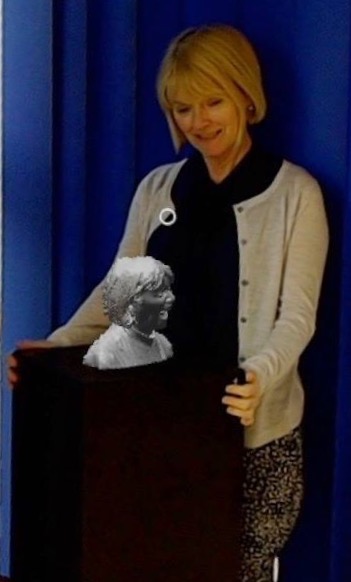
Mixed Reality Projection using Microsoft Hololens
Portfolio – 2019
My art practice is human interest storytelling combining mixed reality with more traditional art installations using sculpture, video, and binaural audio.
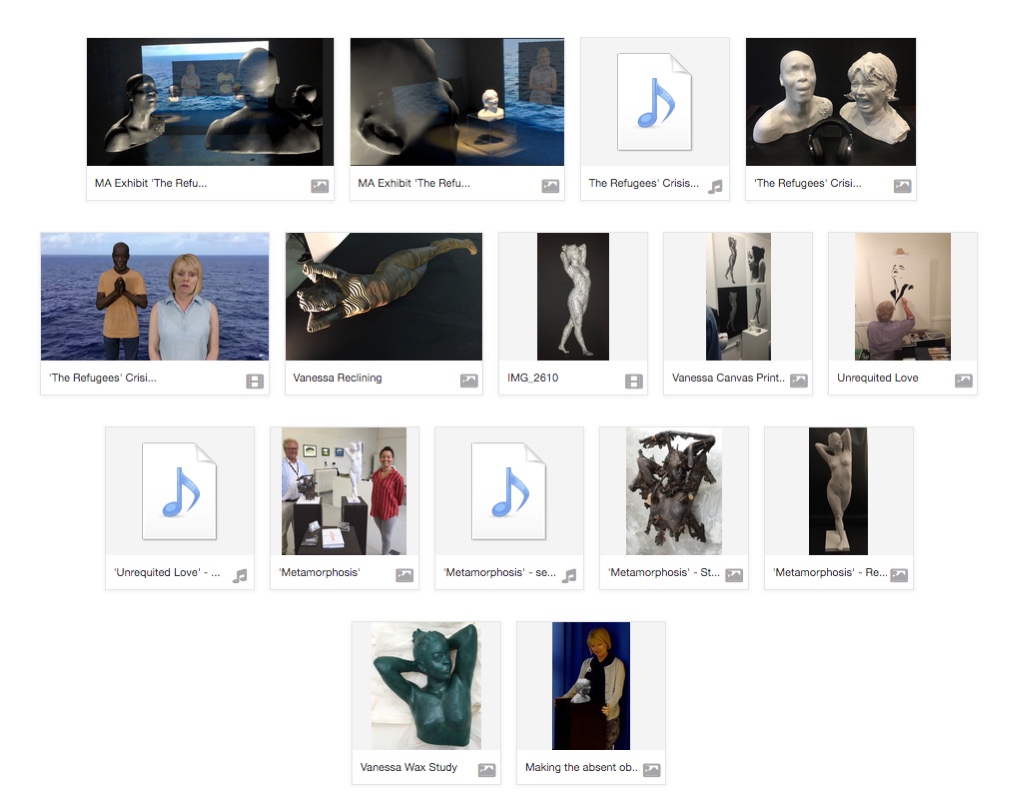
My MA Show art installation ‘The Refugees’ Crisis’ exhibited at UAL in July 2016, tells the true story of refugees fleeing to Europe by boat from Tunisia to Lampedusa which sank, the tragic result of which was discovered by a couple and a few of their friends when sailing on their own small craft – “I have never seen so many in the water”, “We cannot save them all”. This built on the experience of ‘Metamorphosis’, this time using the Veronica Scanner during an RA exhibition at Waddesdon Manor, to make a very detailed life-size 3D print of an actress in the role of Teresa, one of the rescuers. This contrasted with a haunting scan of an actor as a refugee, low morphed, so features were not clear, representing many of those in the sea, not just one person. These sculptures were mounted on clear plinths surrounded by a projected backdrop of the moving sea against the walls and floor, so that the figures appeared to be in the water. Visitors were invited to stand between them. A three-minute binaural recording of the characters’ narrative relating their experience of the same instance when the rescuer and the refugee first saw each other across the water, could be heard through headphones. Three huge holographic copies of the refugee sculpture could be seen against the physical art installation in the exhibition space, along with the binaural recording, using the Microsoft HoloLens mixed reality headset. The visitor could walk around these sculptures as though they were physically present. Many visitors cried including the author of ‘The Optician of Lampedusa’, Emma Jane Kirby, whose book was the inspiration for my work. Penguin donated many copies for visitors to take for an on-line donation to the Oxfam charity supporting refugees. The exhibit was well promoted by the University, which led to the BBC visiting and recording a radio documentary about it for iPM. The Vice Chancellor of UAL, Nigel Carrington bought smaller 3D printed replicas of rescuer and refugee, which are now on display in his office. On 26 February 2018, I will be presenting and exhibiting this installation again at St. Hugh’s College, Oxford University.

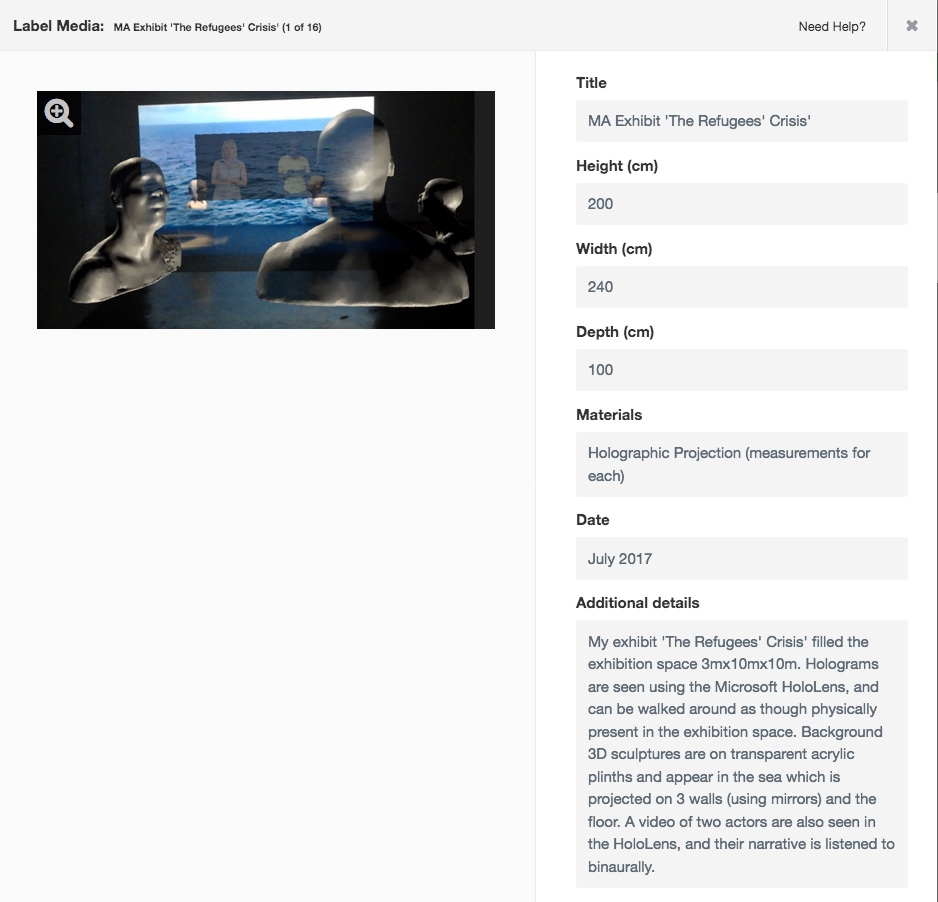

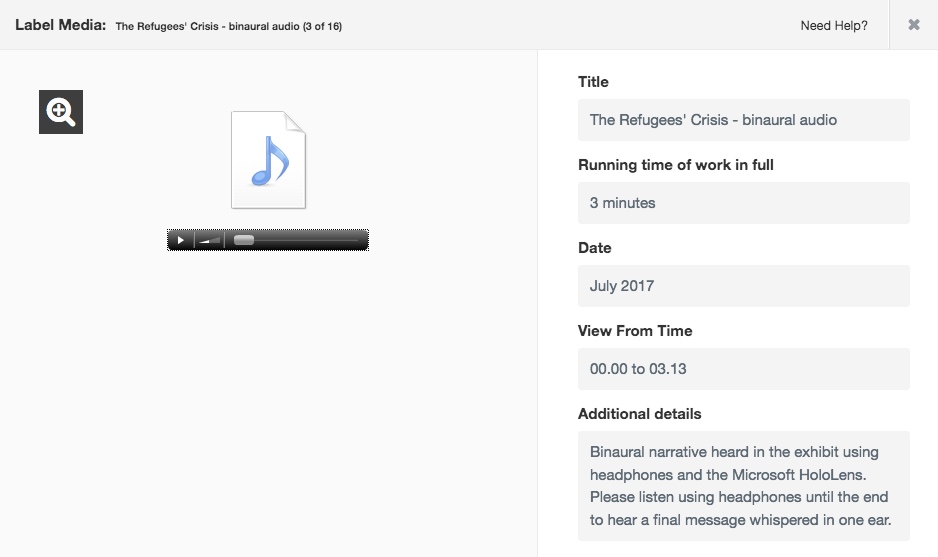
For the binaural effect please listen to the audio below using headphones.
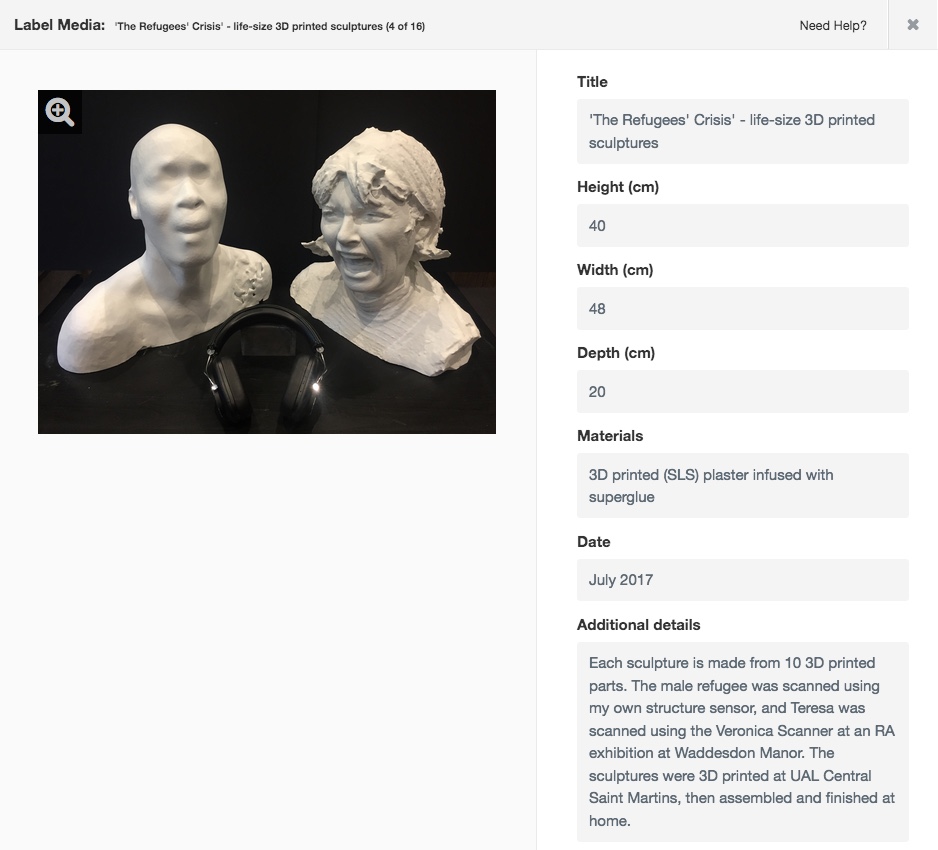
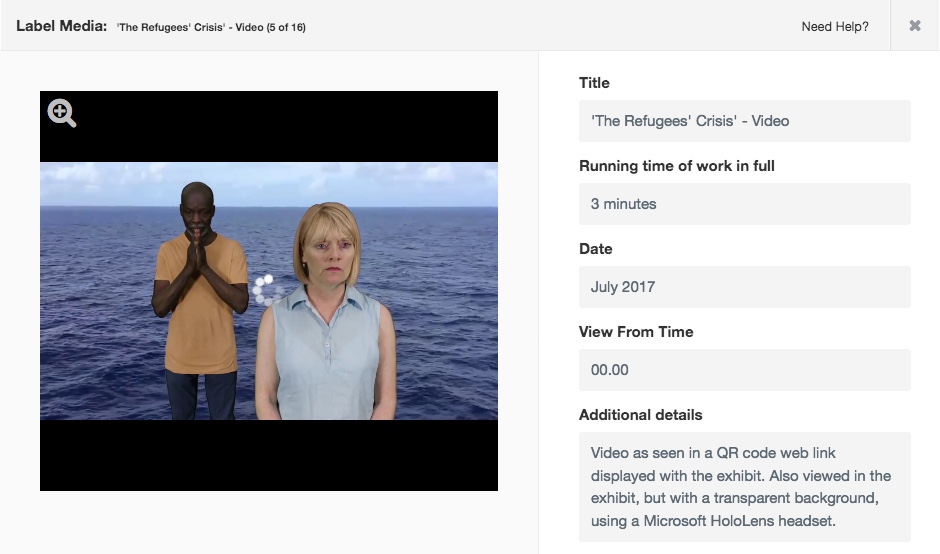
There were many experimental steps along the way: A half size sculpture of Vanessa in pose, made of 250 laser cut slices of MDF; a touch narrative painting ‘Unrequited Love’ which held a conversation with the viewer as he/she touched different parts of the canvas. The viewer is the object of affection of the woman in the painting – “Why did you ignore me today”; large canvases of the 3D scans of Vanessa, morphed as a harlequin or as an intricate mesh which is projected and rotated.
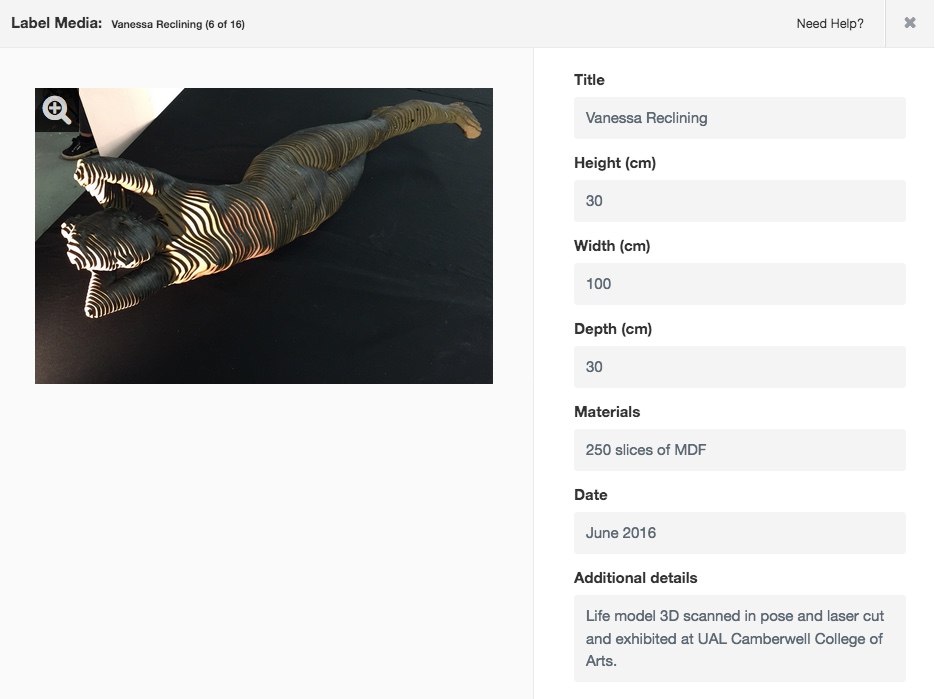
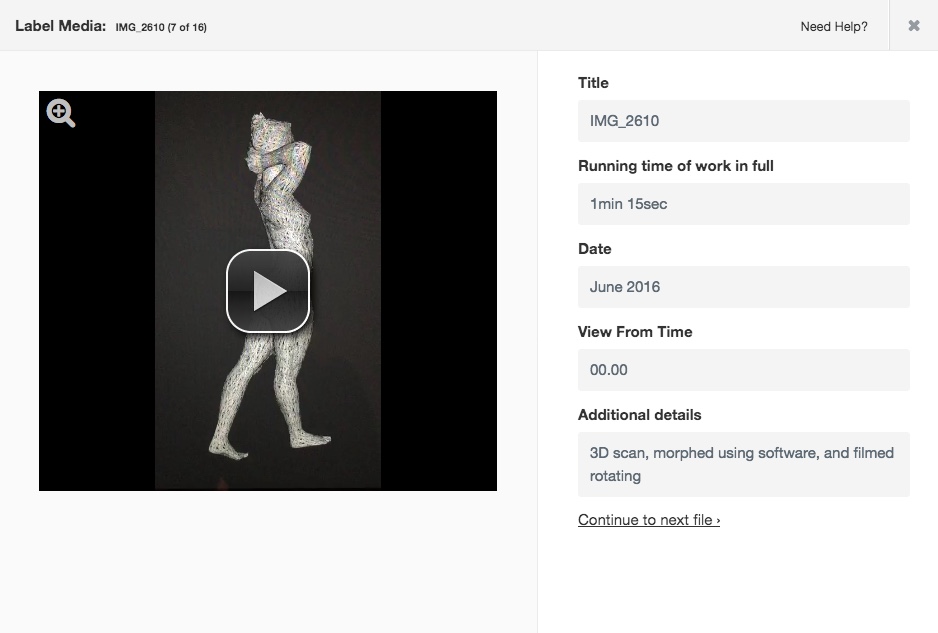
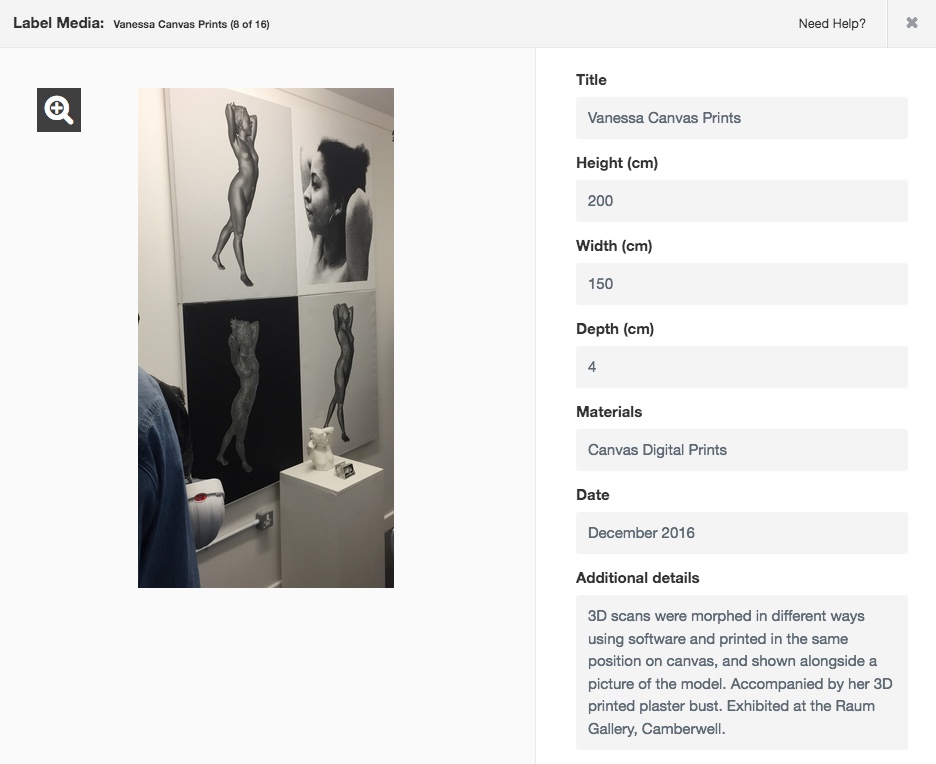
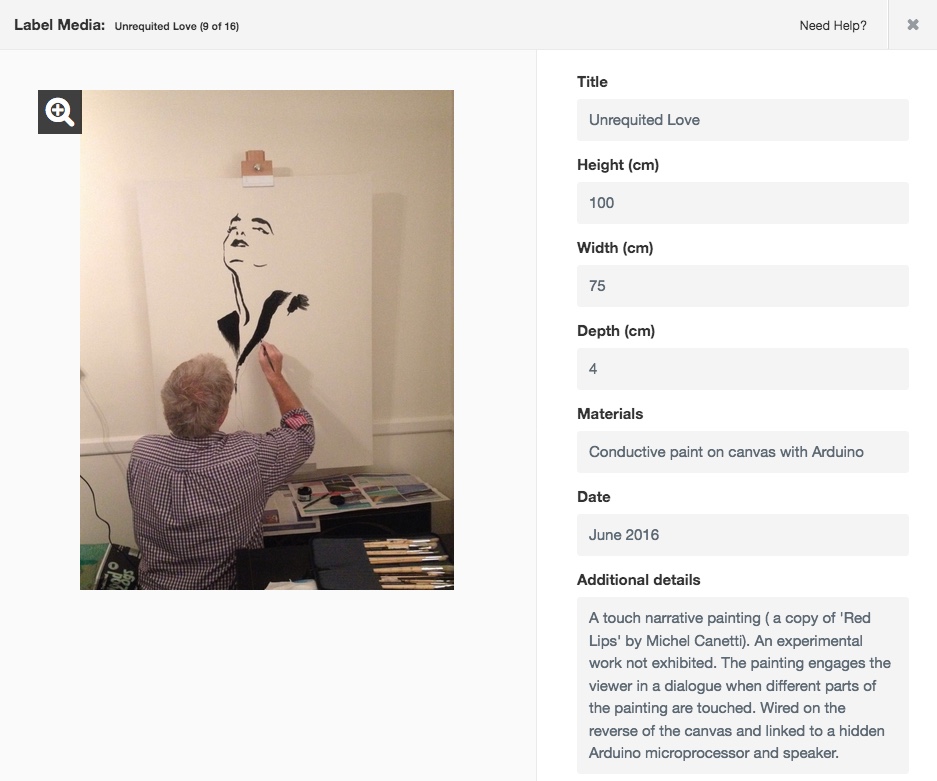
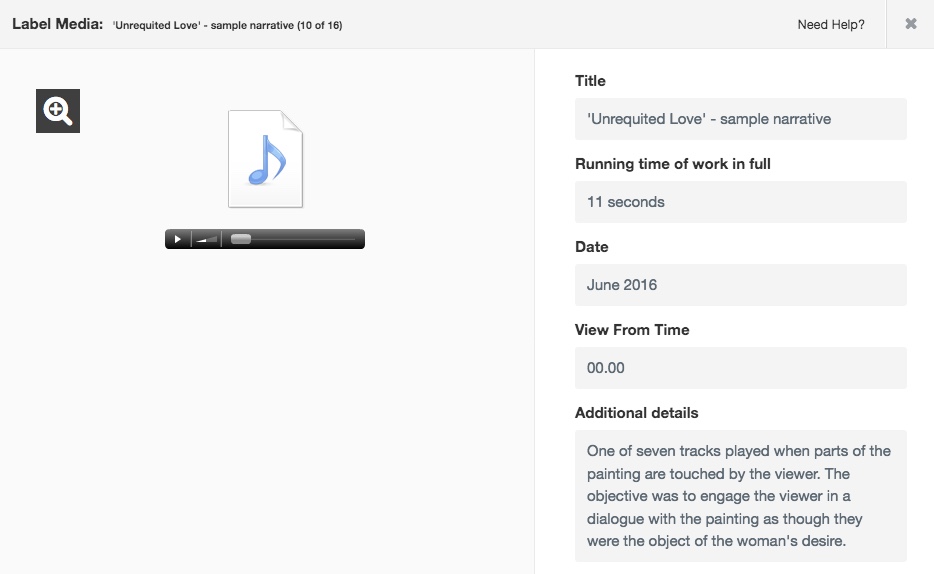
My MA Display exhibit, ‘Metamorphosis’ builds upon my ‘Digital to Physical’ practice. I used 3D scanning, photogrammetry and 3D printing processes developed by Factum Arte, part of the Factum Foundation, which reconstructed demolished heritage such as the Arch at Palmyra destroyed by ISIS. With my own hand held scanner and the SLS 3D printer at Central Saint Martins I produced a one-third size scale sculpture of Vanessa Abreu, a life model I had previously drawn. I then used the 3D printed sculpture to make the mold from which I cast her upper body in bronze, leaving it with runners and riders exposed and unpolished to represent the stress experienced when she damaged her knee during a contemporary dance performance at Sadler’s Wells. The full body 3D print in smooth sandstone, in contrast represented her metamorphosis into a successful life model at the Royal Drawing School. I recorded Vanessa’s story in her own voice, and parts of her narrative are played randomly when the book ‘Metamorphosis’, displayed with both sculptures, is touched by a viewer – “I did not know whether I would ever dance again”. There is no evidence of the technology, and the book can be lifted off the plinth it rests on, with no wires attached. My aim is to gain an empathic response from the audience from the visual and audio cues alone, without intrusive evidence of the technology employed.
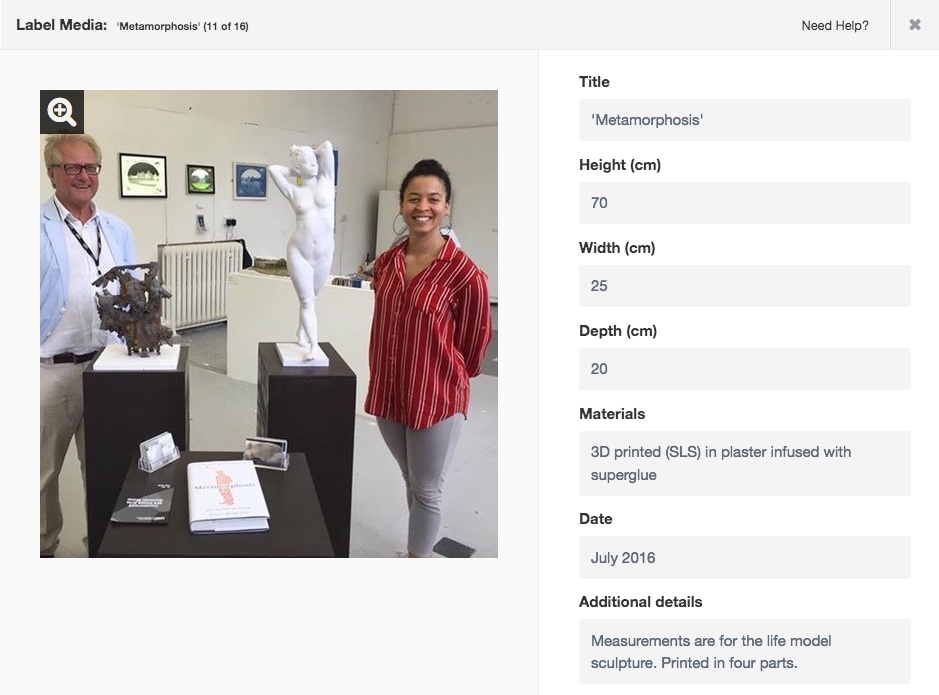
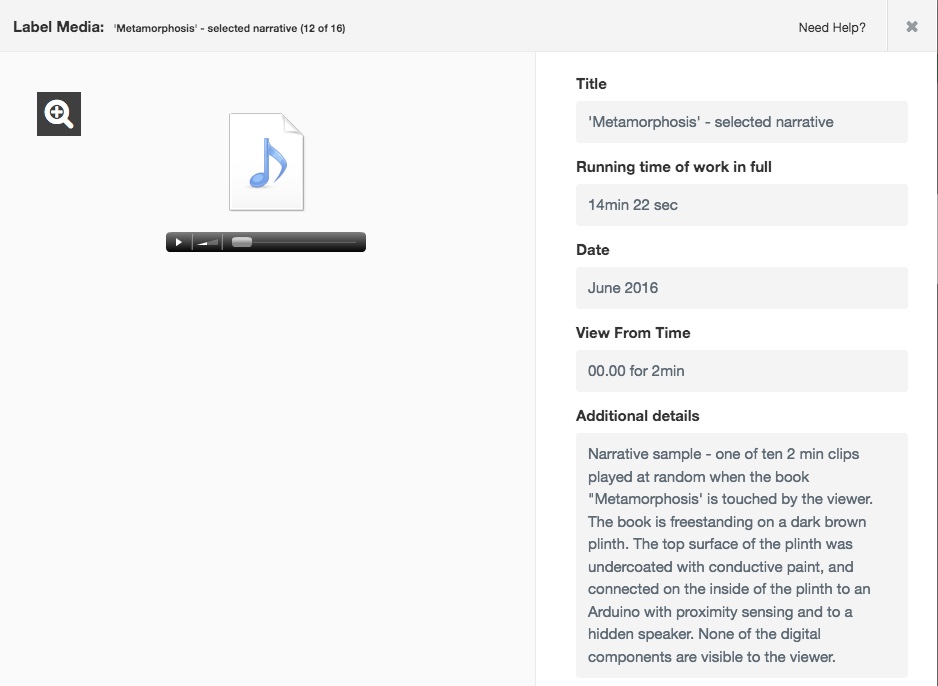
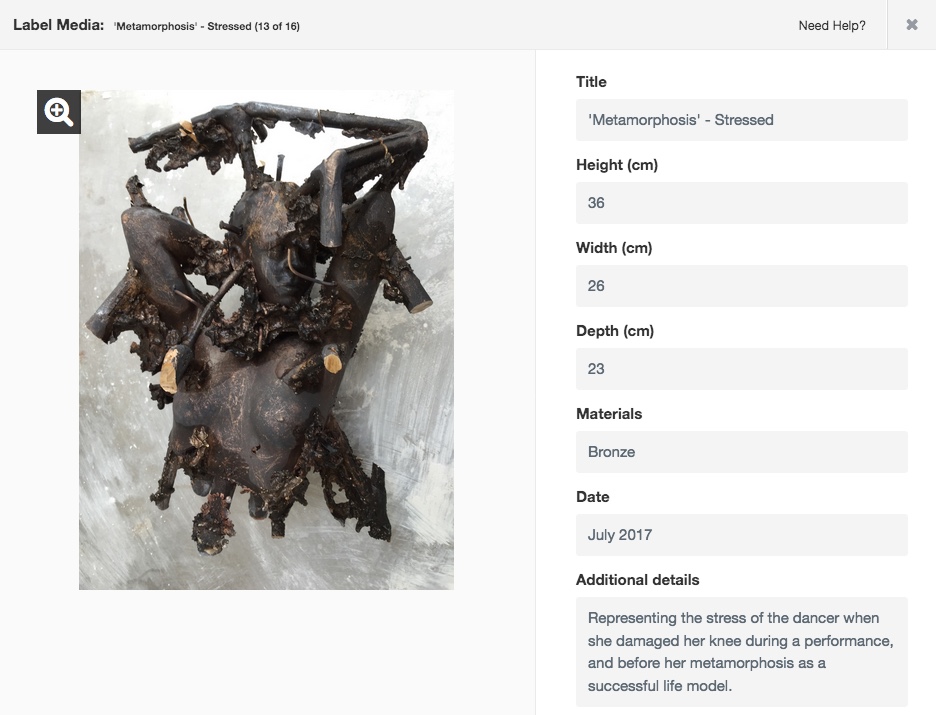
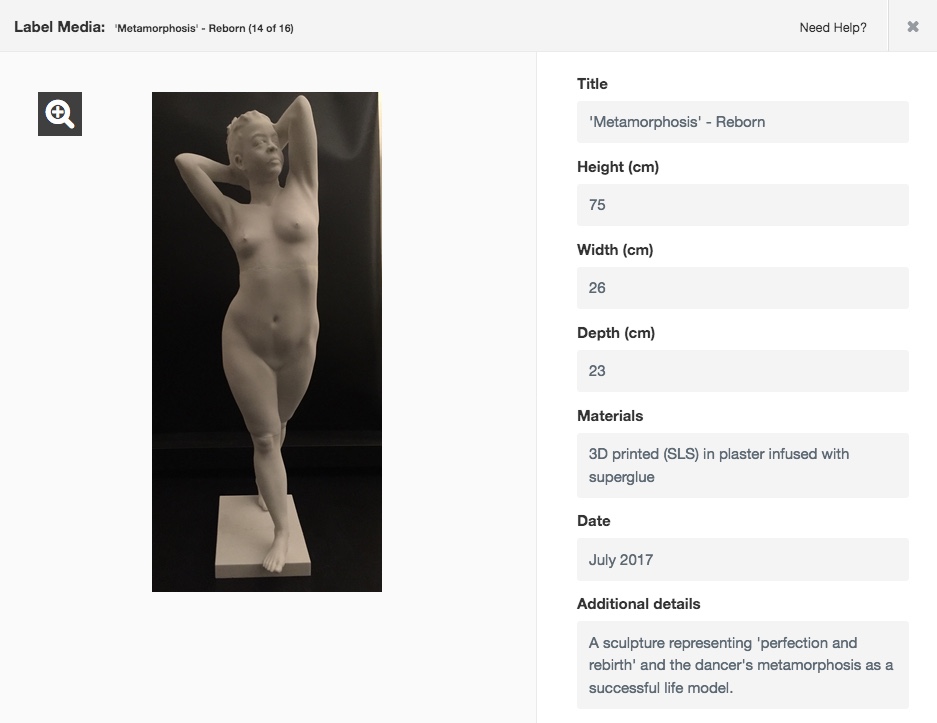
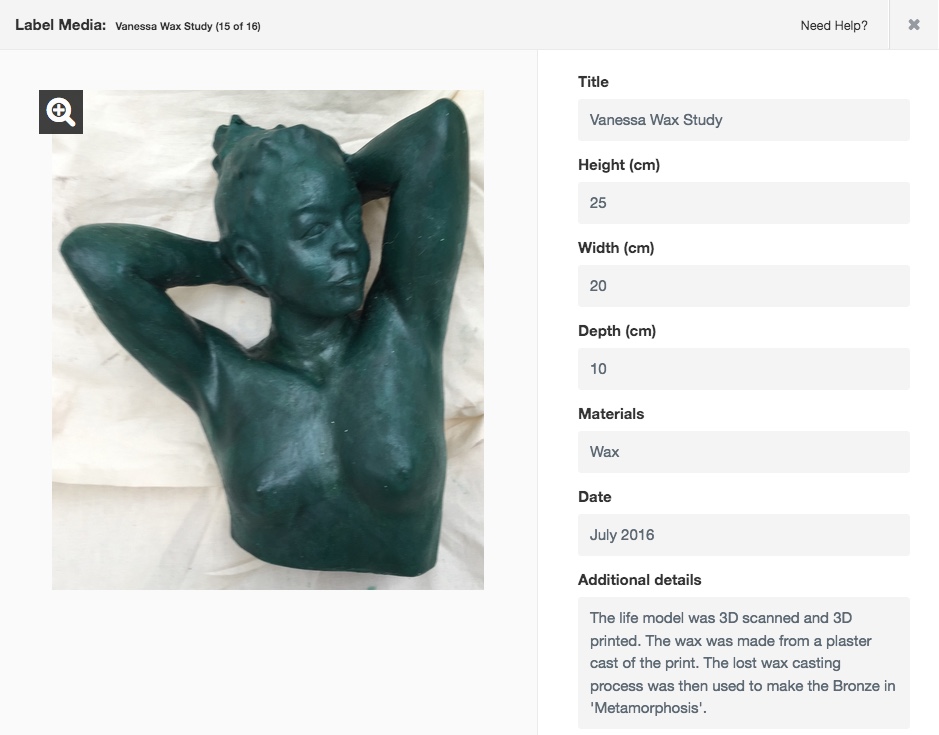
In April 2017, I took part in a demonstration to V&A academics of my exhibit Making the absent object present. Wearing a Microsoft HoloLens headset, participants walked around a hologram of my 3D sculpture, displayed in exactly the same place as the removed original (also shown at Tate Exchange: Tate Modern, Kingston University and The Museum of Futures, London).
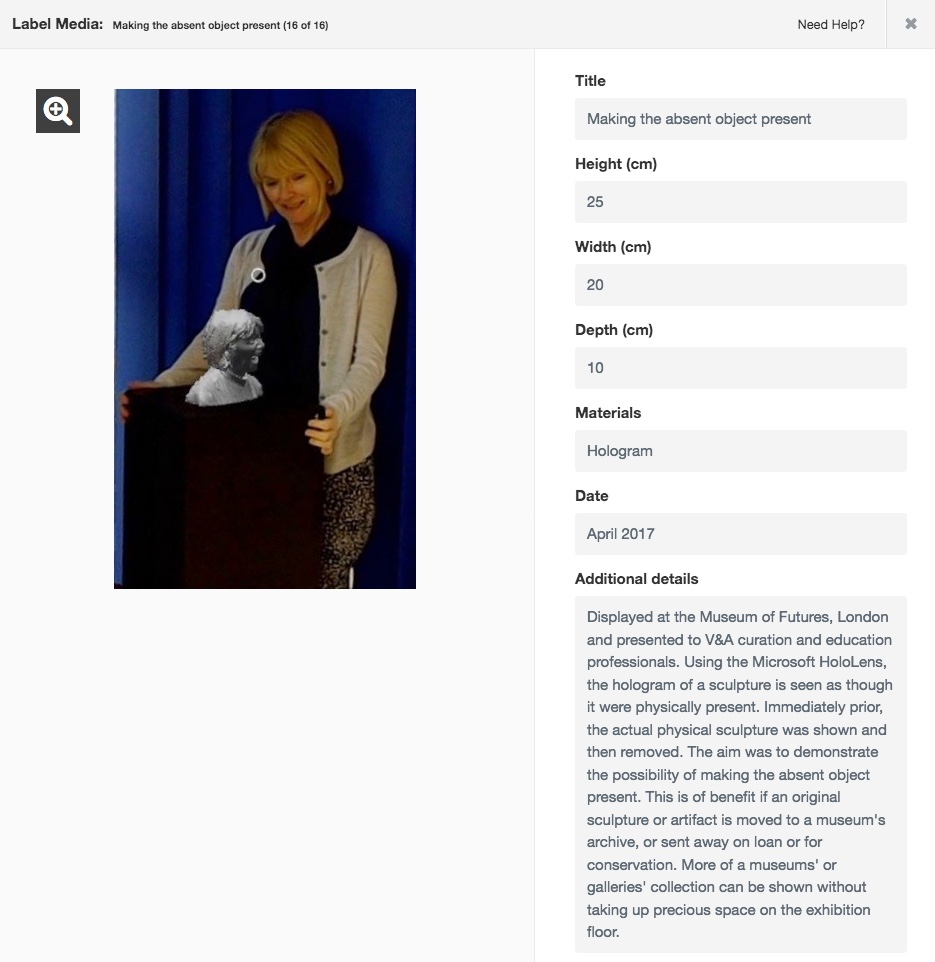
Earlier this year I demonstrated and helped visitors experience these technologies, including Tilt Brush Virtual Reality and Mixed Reality, at Chelsea College of Arts, Camberwell College of Arts, and at several sessions of Tate Exchange at Tate Modern.
Unit 2 Assessment and Final Post
Summary
My first thought when starting this Unit 2 self-assessment was the same as for Unit 1, “I wish I had blogged about many more activities and experiences I have engaged in during my MA”. One of my personal study objectives was to gain as much of an art school experience as possible and to add as many skills to my art making ‘toolbox’ as feasible in the time available, and I feel I have achieved this. Over the two-year MA I have applied myself pretty much as I would in a full time job and taken full advantage of UAL facilities at Chelsea, Central Saint Martin’s, Wimbledon, and Camberwell as well as the Tate Exchange and activities at other universities including Kingston and University College London. I have also attended many conferences and exhibitions, particularly around the topic of virtual and mixed reality. I have entered the Lumen Prize last year and this.
https://terencemquinn91.org/2017/07/05/lumen-prize-entry-2017/
In this post, I have therefore also commented on activities I did not have time to include in my blog, alongside those I have referenced. My WordPress blog is nevertheless seventy-thousand words.
Jonathan originally commented on my first project proposal “Terry, you have five MA’s here”. At the end of Unit 1 most of these five objectives were achieved and practically demonstrated in my art exhibits. My Unit 1 focus was around the life model and with ‘digital to physical’ art making. My practice development in Unit 2 continued at a similar hectic pace, but with much more focus and clarity of purpose. Reflecting on Unit 1, made me realise that my work, which started with the idea of “giving the model a voice” had become about story-telling, mixing digital with physical components to create a narrative, with the aim of gaining an empathic response from the viewer. I have since built on the skills gained in the first year by extending my art to include what is referred to as the ‘empathy’ engine, namely Virtual and Mixed Reality. These are evident in my MA Show exhibit ‘The Refugees’ Crisis’ which combines a short film with binaural sound recording, 3D digital sculpture and Mixed Reality using the Microsoft HoloLens, none of which I had any familiarity with before this course.
My MA Fine Art Digital journey has been an exciting and exhilarating experience which has enabled me to become the artist I have always wanted to be. What next, beyond my plan described later, for continuing my personal and professional development, is still an open question. A holiday or two are planned, but I am not good at having nothing much to stimulate me for long.
I have applied for a part-time position as Assistant Curator, Digital Learning at Tate based at Tate Britain and Tate Modern. I have also been invited to re-apply to two universities (Kingston and UCL jointly supervised by Nick Lambert at Ravensbourne) after completing my MA. Both said that they would offer me a place as a PhD student based on my proposal, but either did not have a suitable supervisor or the proposed supervisor was currently overloaded.
https://terencemquinn91.org/2017/07/05/its-not-easy-to-find-a-phd-supervisor/
In the meantime, I am following up the possibility of continuing my research (with the hope of attracting a suitable University) by involving a business or art institution on AHRC’s Collaborative PhD track. I have an introduction outstanding to the head of the digital art collection at the V&A by one of their senior curators, and a Microsoft Evangelist (their title!) has followed up my discussion with him with the appropriate contacts within Microsoft, but I have yet to chase this. Prof. Stephen Farthing also said that he would endorse an application to Linda Drew, Principal at Ravensbourne, whom he knows well, suggesting that I do Post Doc equivalent research at Ravensbourne based on my PhD proposal (Ravensbourne do not currently offer PhDs). I have also thought of applying to the Slade School of Fine Art or re-applying to the Royal College of Art. However, I think a year out is on the cards, and probably a good idea. It will give me time to think things through while I continue my art making. A Residency appeals, but we will see. C’est la vie. What will be will be.
https://terencemquinn91.org/2017/04/20/life-on-mars/
I have presented my assessment under the three learning outcomes but an overview can be found in my Symposium 2 Video
https://terencemquinn91.org/2017/05/31/symposium-2/ or on YouTube https://youtu.be/Z-2fTKzzQks
Present a resolved body of original creative practice that has evidenced the systematic enhancement of your knowledge and understanding
My passion immediately before joining the MA was life drawing, and this became my starting point for Unit 1. My focus in the first year was almost all around the life model and ‘digital to physical’ art making. I felt it important to state this as the skills I gained in Unit 1 were entirely new to me and proved an essential foundation for developing my art practice in Unit 2.
My project proposal was ambitious; some would say overly so, including the view of Jonathan as I’ve noted earlier. However, by the end of Unit 1 most of the objectives I set myself were achieved and demonstrated in my art making culminating in my MA Display, ‘Metamorphosis’.
In my first term at Camberwell, I made a full body scan of my life model Vanessa, used this to laser cut 250 slices of MDF, and built a metre-tall sculpture which I exhibited at our first pop-up show. Jonathan later remarked that this was something he would not have expected from a student until the end of Unit 1. Using the same scan, at CSM I 3D, I printed a 75cm tall sculpture in hardened plaster. I taught myself to morph 3D scans, turning them into large digitally printed canvases and rotating 3D projections. Through the UAL Digital Maker Collective at Chelsea, I acquired skills around the Internet of Things (IoT) and used them to make the sculptures and images on canvas speak when touched or approached. In a tutorial with Prof. Stephen Farthing he remarked on the uniqueness of my work, and that he could envisage an art exhibition devoted entirely to talking sculptures concluding. “What would a pineapple say, or a Kalashnikov?” I therefore believe that I used my newly found skills in an original and creative way, further evidenced here in my Unit 1 assessment:
https://terencemquinn91.org/2016/10/21/unit-1-assessment/
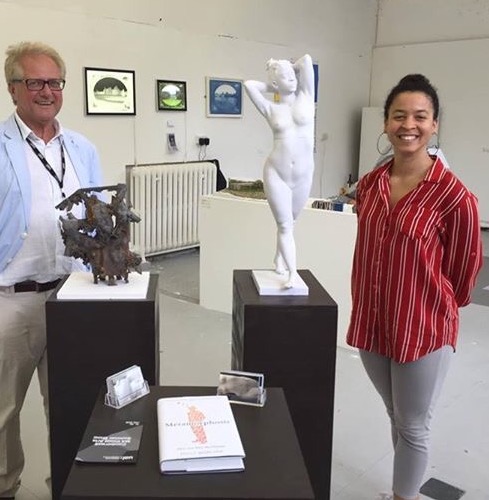
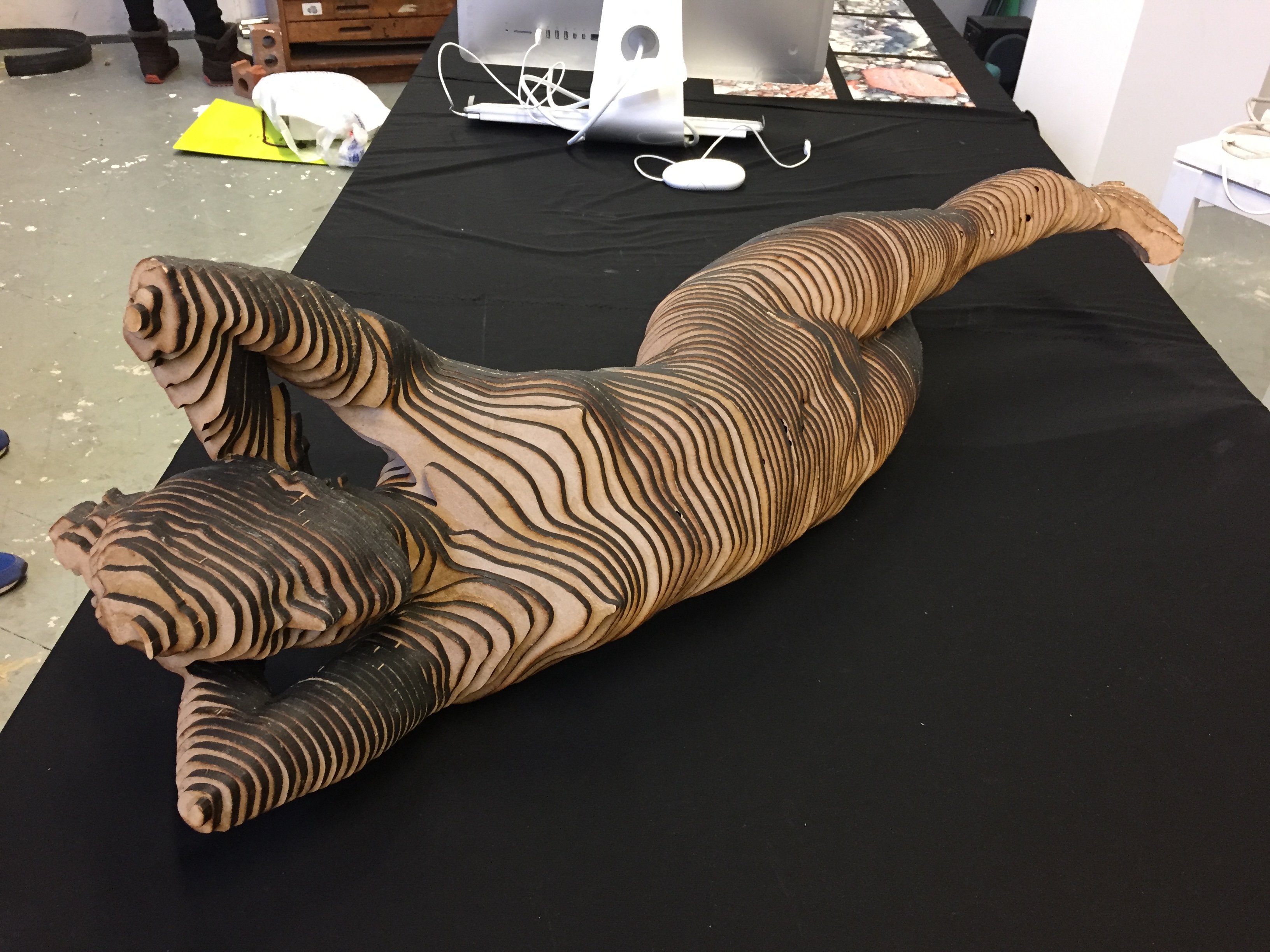 Some of my work in Unit 1
Some of my work in Unit 1

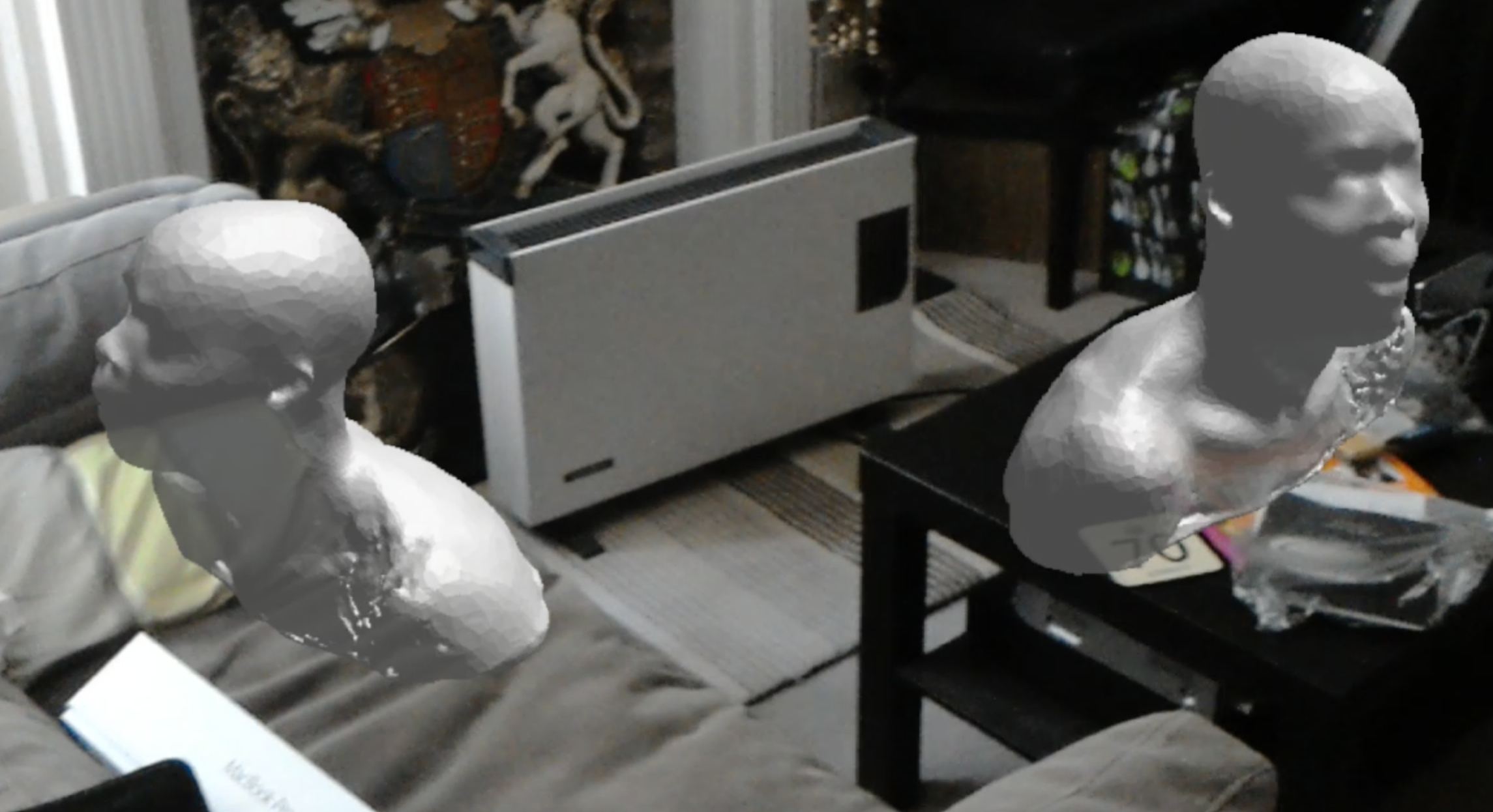 Holograms created in Unit 2
Holograms created in Unit 2
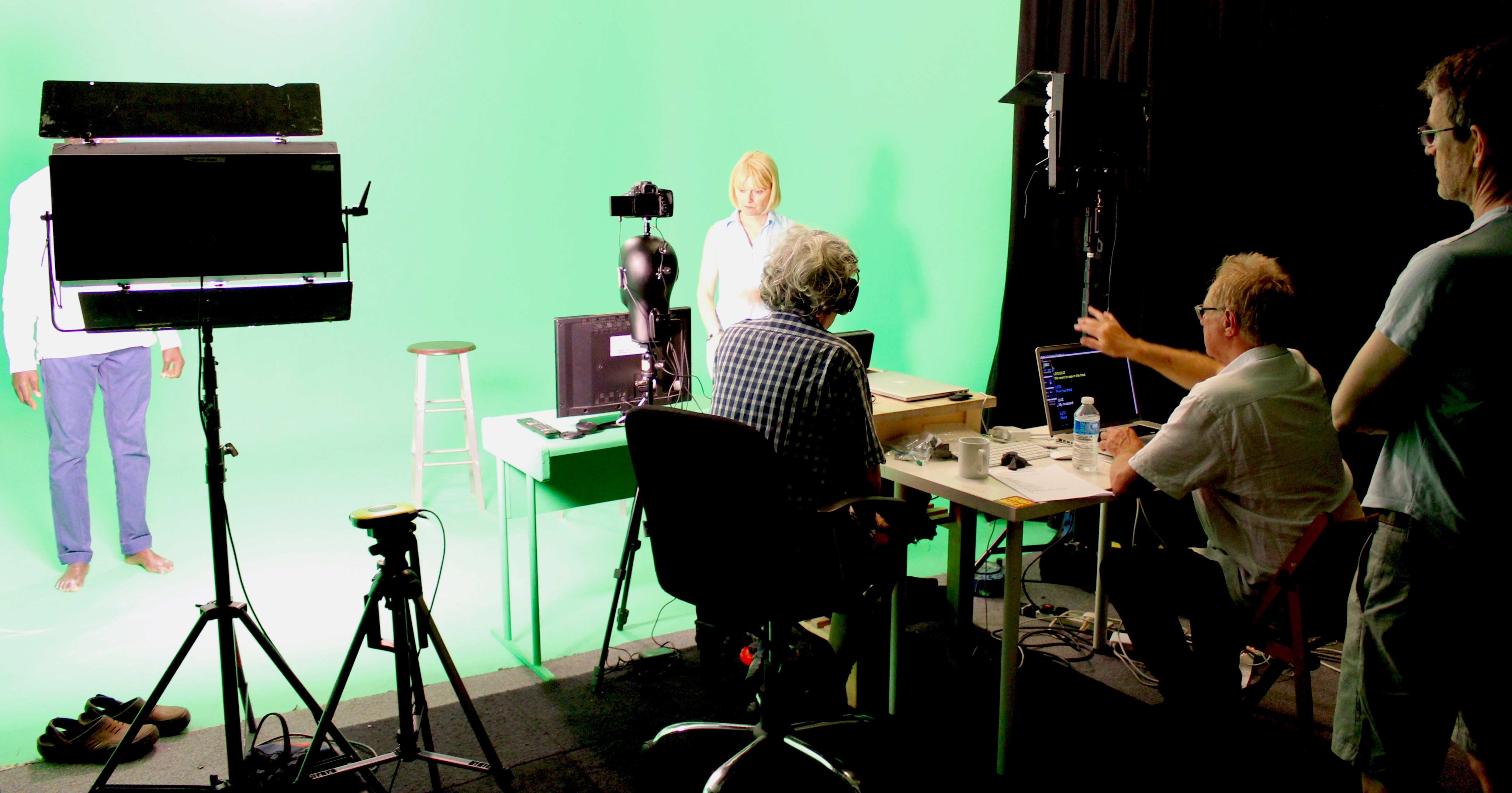 My MA Show Exhibit in Production
My MA Show Exhibit in Production
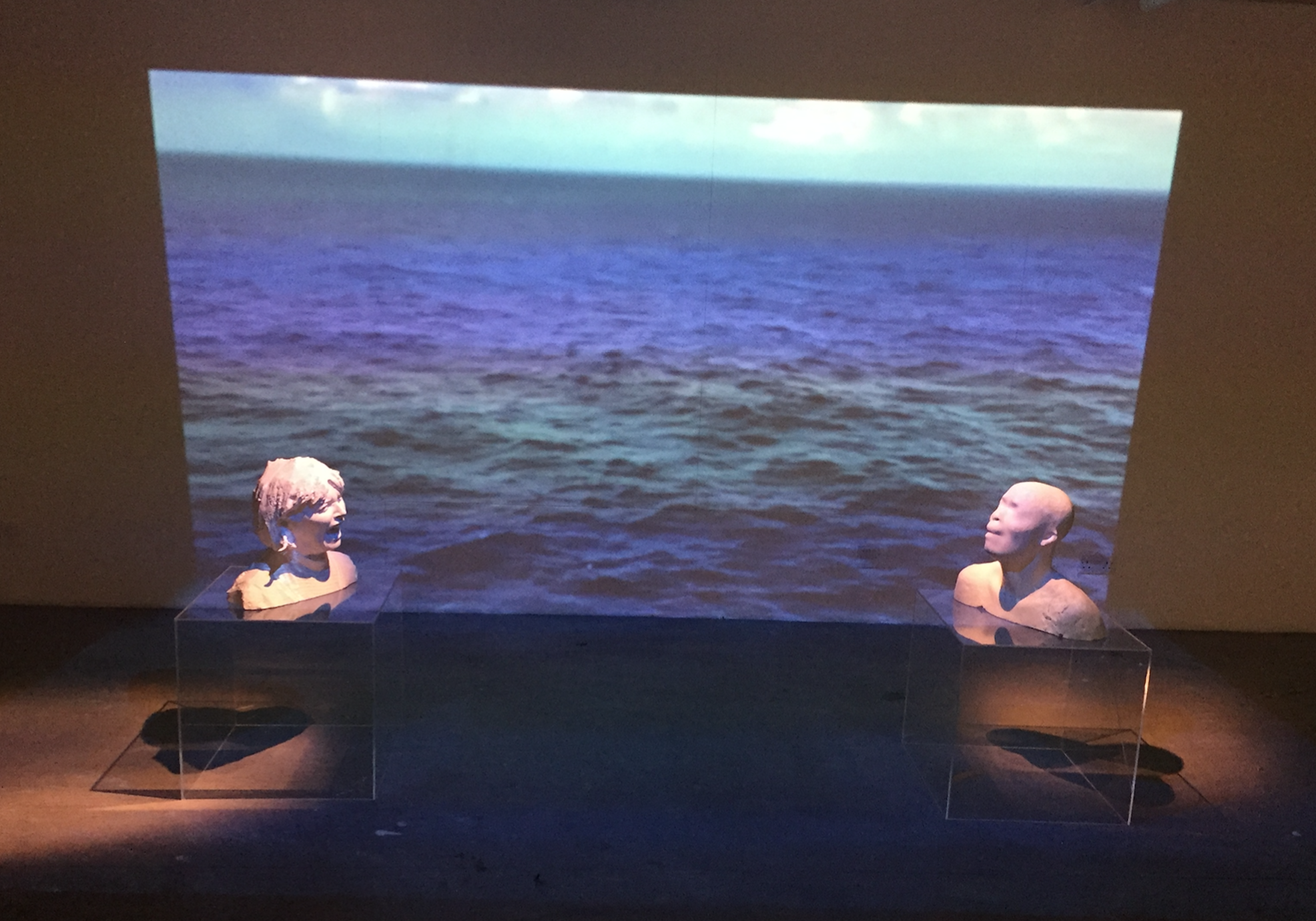
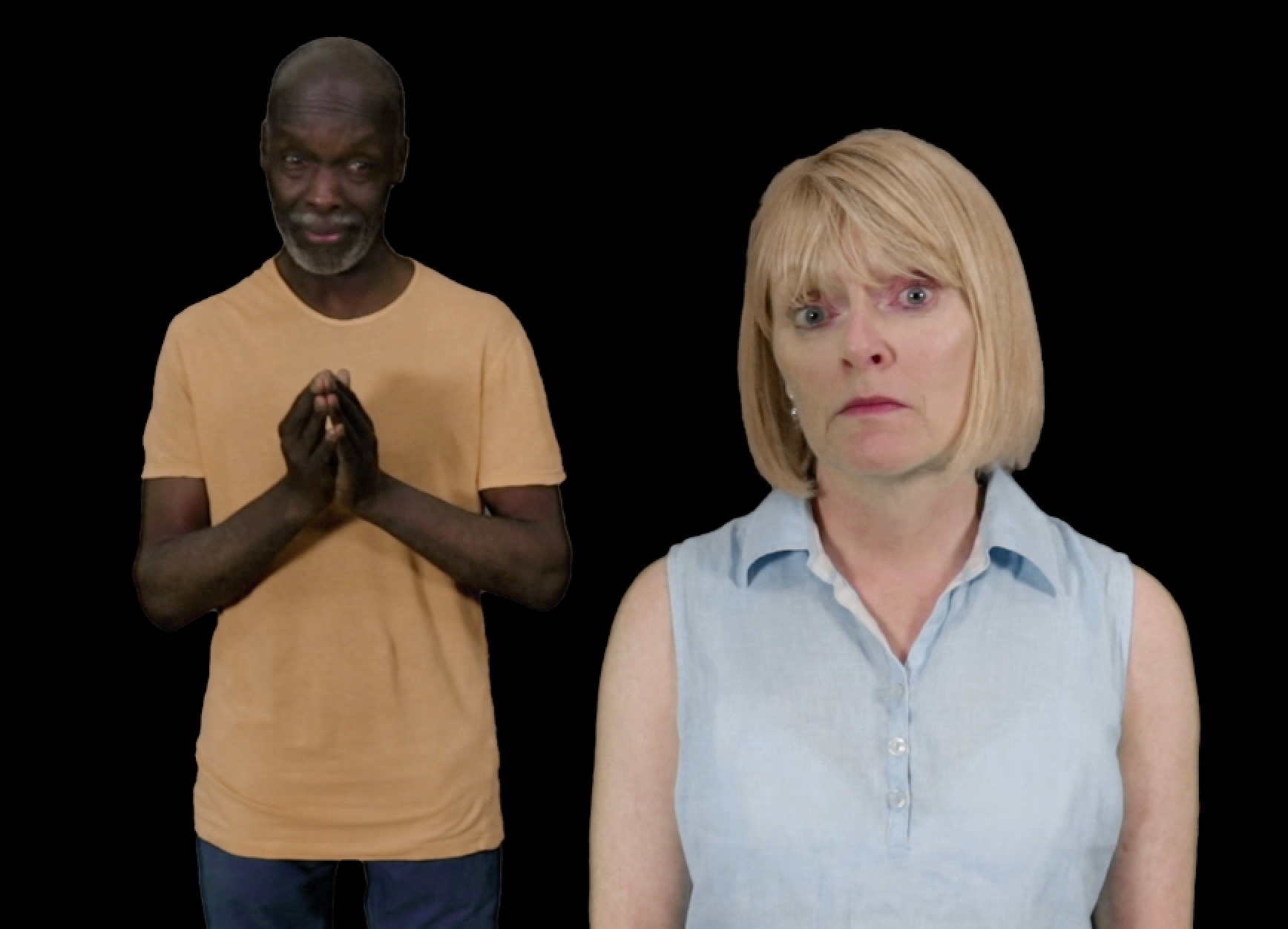
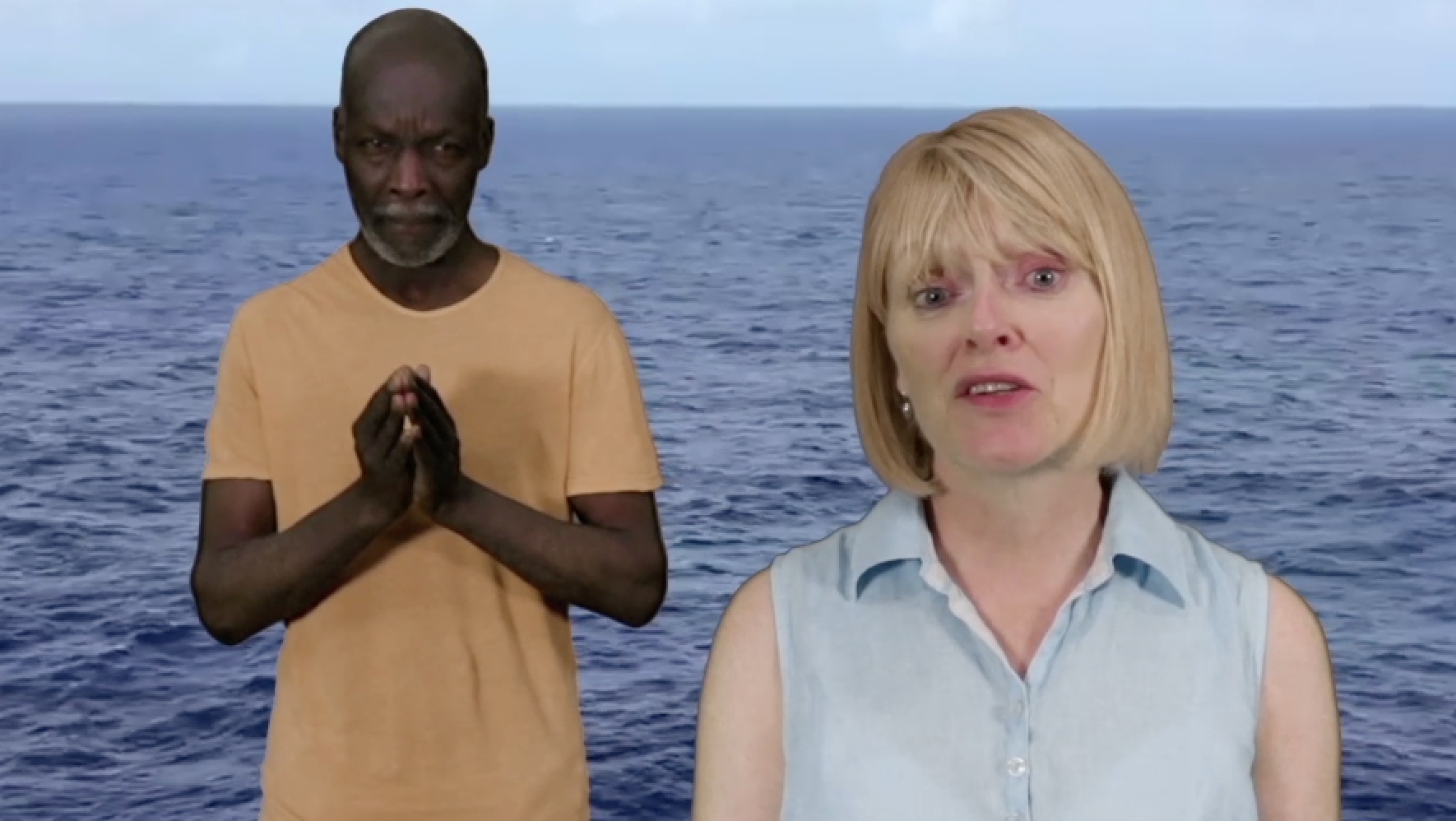 MA Show Exhibit
MA Show Exhibit
My practice development in Unit 2 has continued at a similar hectic pace, but with much more focus and clarity of purpose. My research paper is concerned with built-in obsolescence in born-digital art and the consequent ‘digital gap’ in our future cultural legacy.
This led me to research Mixed Reality (an advanced form of Augmented Reality) as a possible solution, and subsequently to incorporate it into my art practice.
https://terencemquinn91.org/2016/10/24/double-me-plan-to-make-an-augmented-reality-video/
I have since demonstrated ‘making the absent object present’ to V&A educationalists and curation professionals, showing how art objects and installations could be experienced in the present as they were exhibited in the past, using one of my MA Show 3D scanned and printed sculptures as an example.
https://terencemquinn91.org/2017/04/14/using-my-hololens-and-sculpture-at-another-ma-show/
https://terencemquinn91.org/2017/03/27/tutorial-with-jonathan-kearney-24-march-2017/
This is the basis of my PhD proposal for which I am still seeking an appropriate supervisor.
https://terencemquinn91.org/2017/03/07/post-ma-research-project-the-virtual-museum-of-modern-art/
I demonstrated my research into Virtual Reality using the HTC Vive, and Mixed Reality using the Microsoft HoloLens at all four sessions of the Tate Exchange organised by the UAL Digital Maker Collective, as well in our studio and during our last Low Residency.
https://terencemquinn91.org/2017/04/14/experimenting-with-my-hololens-for-my-ma-show-exhibit/
https://terencemquinn91.org/2017/04/04/ma-show-alternatives-to-mixed-reality-video/
https://terencemquinn91.org/2017/03/11/reflections-on-further-study/
https://terencemquinn91.org/2017/03/07/tate-exchange-virtual-and-mixed-realty/
It is this technology, sometimes referred to as an ‘empathy engine’, which gave me the idea to include MR in my MA show exhibit about the Refugee Crisis. I wanted to include the empathic effect I could gain from the use of this technology, for the viewer to experience the viewpoint of the refugees, rather than the problems we perceive they are causing us in Europe. It is titled ‘The Refugees’ Crisis to reflect this. This art installation combines a binaural sound recording, background films using stock video clips of the sea, and 3D printed sculptures of two actors as a refugee and one of his rescuers.
https://terencemquinn91.org/2017/04/08/progress-making-my-ma-project-background-video/
The Microsoft HoloLens shows the actors’ silhouettes filmed against a green screen, later edited to black (transparent) with a binaural recording of their narrative, alongside several huge scale holograms of refugees in the sea. This artwork has required me to learn many new skills and put them into practice alongside those I learnt in Unit 1.
https://terencemquinn91.org/2017/06/03/my-ma-show-the-hololens/
https://terencemquinn91.org/2017/04/08/preparing-to-film-my-actors-in-green-screen/
I taught myself how to play a sound recording, at the same time as projecting holograms into the real world around the viewer using the HoloLens headset. I tried and failed to incorporate video into this combined experience. To do that I needed to develop a Unity project and deploy it to the HoloLens. This was eventually achieved over many sessions and a lot of handholding and heartache in the Advanced Digital Projects Department at CSM.
To make a short professional film to be shown in the HoloLens, I needed to use a professional green screen recording studio. Sadly, I could not gain access to these facilities and expertise at Wimbledon or CSM. So, with some first and second year MA FAD colleagues, we pooled our knowledge and experimented using the portable green screen set up in Camberwell Digital Media. It was there that I also learnt about sound recording and editing, building on an invaluable session with Ed on Audacity software. Alasdair and I later established our own much larger green screen facility at Alasdair’s home studio. There we experimented with recording and editing, including different sound recording methods in particular using a binaural head. This experience was invaluable when finally making my film at a commercial facility, Camberwell Studios.
https://terencemquinn91.org/2017/03/18/preparing-to-make-my-ma-project-holographic-film/
To make the film, I was fortunate to be able to involve two professional actors including my wife, a professional scriptwriter/film maker, and Donald as camera man and film editor. I took the roles of producer, director and autocue operator! Over twenty-seven takes in one day (I was the taskmaster) we made a three-minute binaural sound recording and two short films in single takes.
To make the sculptures, my wife was scanned using the Veronica Scanner developed by the Factum Foundation for restoring destroyed ancient monuments (e.g. from Palmyra). The actor taking the part of the refugee was scanned in the Camberwell photographic studio.
https://terencemquinn91.org/2017/01/24/progress-on-mixed-reality-ma-project/
https://terencemquinn91.org/2016/10/24/veronica-scanner-i-am-the-model/
Both sculptures were made in ten pieces (because of the maximum print dimensions of the CSM 3D printer) which I assembled, finished and painted at home. I had experimented with my own Ultimaker 3D additive printer, but as it took seven days continuous printing to make one part, this was quickly (or should I say very slowly) abandoned in favour of selective laser printing at CSM.
https://terencemquinn91.org/2017/04/08/progress-making-my-ma-project-sculptures-life-size/
https://terencemquinn91.org/2017/03/27/making-my-ma-project-sculptures-life-size/
https://terencemquinn91.org/2017/03/18/making-my-ma-project-background-video/
Putting this all together in an art installation for my MA show has been an education in itself but I have yet to finish my blogs about that.
https://terencemquinn91.org/2017/06/20/guide-to-my-ma-show-exhibit/
https://terencemquinn91.org/2017/05/11/ma-show-preparation-11-may-2017/
https://terencemquinn91.org/2017/03/04/draft-project-plan-for-my-ma-show-exhibit/
Analyse and critically reflect coherently upon your own practice and its context
The development of my story-telling focus did not progress linearly or logically, but emerged from trying to build a toolkit of skills which I felt necessary to express myself artistically, pursuing my interest in people and their life experiences.
https://terencemquinn91.org/2016/10/21/unit-1-assessment/
https://terencemquinn91.org/2017/01/24/progress-on-mixed-reality-ma-project/
https://terencemquinn91.org/2016/11/04/ideas-for-a-mixed-reality-short-film-for-my-ma-show/
I was made to realise and confront the fact that cultural sensitivities need to be taken into account in my work. This was evident in crits of my work from fellow students and tutors where strongly held opposing views were expressed about my idea of touching a nude female sculpture to elicit a recorded voice response. I admit that my personal view concurred with that of Prof. Farthing who said in one tutorial “you are at an art school, not a monastery”, but in the end I deferred to respect the alternative view by triggering the voice of the model by touching a book with the same title as the artwork ‘Metamorphosis’. This was after a hilarious and abortive attempt at home, experimenting with how I could allow the model’s head to be touched but not the rest of her body, and how I could impart this request to the audience!
Gaining an emotional response from the viewer has become an important objective in my artwork. I aimed to do this sympathetically to the subject and audience and not by shock tactics. However, I realise that the combination of artistic devices I have used in my final MA show art installation makes the work extremely hard hitting and with no holds barred. Perhaps this comes from my own strong feelings on the issues raised? Now I believe it important to hold a personal view about important issues and express it through your art. Art can open peoples’ eyes to situations in imaginative and stimulating ways that mere factual reporting cannot.
I understood early on that I should not allow myself to be seduced by technology as I admit that I am, as Ed recently jokingly called me, a “Gadget Man”. I am fascinated by new technology and its potential uses, which was the basis of my previous business career, but I also know that the technologies I use are just tools for artistic expression. New technologies have been quickly adopted by artists through the ages, including for example devices to aid painting in perspective, new materials and paints, photography, moving image and so on. Grayson Perry, our UAL chancellor made his ‘Walthamstow Tapestry’ using Photoshop software and a computer loom in Flanders, and had a Wacom tablet in the backroom of his studio when I visited. So I make no apologies for my use of emerging technologies to aid my creativity and artistic expression, alongside those that have already become well established in the art world. Artists often push the boundaries of what is possible and are early adopters of whatever new opportunities present themselves. I am now very comfortable with that in my own art practice. New technologies deployed in one’s artmaking are not gimmicks when used thoughtfully with artistic purpose.
I have reflected on the saying ‘Less is More’.
https://terencemquinn91.org/2017/04/15/ma-show-overview-narrowing-down-options/
This was raised in a tutorial with Prof Lucy Orta at the London College of Fashion when discussing my proposed MA project about the plight of refugees. The meeting followed my attendance at her Passagens seminars at the London College of Communication.
Yet I have included many of the elements that she encouraged me to consider dropping to make my message simpler and thus stronger. This point was also raised by one of my fellow students when I demonstrated the HoloLens during the MA Show build. I have considered that I may be over attached to elements of work which I have put so much effort into and where others have been intrinsically involved. Dropping any element would be an emotional wrench for me I must admit. But I feel that I resolved this matter by separating the work into layers which work independently. The background videos of the sea can be likened to a simple backdrop on a stage. The sculptures are mounted on transparent plinths with the aim of invisibility to the viewer as far as possible. The binaural recording by necessity needs to be heard through headphones and therefore does not intrude on the visual presentation. The film, with the green screen replaced by the sea image in the background video, is only seen when the viewer initiates it using a displayed QR code.
https://terencemquinn91.org/2017/06/19/bookmark-for-the-refugees-crisis/
https://terencemquinn91.org/2017/04/24/ma-show-proposal/
https://terencemquinn91.org/2017/03/18/making-my-ma-project-background-video/
The HoloLens video shows the actors only against the visual background in the real world of the exhibition space, alongside huge holograms of the refugee, both experienced personally through a headset, again not intruding on the visual set of the main exhibit. Whether this works in practice remains to be seen, but I am hoping that it will. I will in any event learn from this experience and it will inform my practice in future.
Finally, I refer to a discussion during my last tutorial with Jonathan when I showed him my intended life size holograms of the refugees in the sea. We argued about whether this was more appropriate to the message I was trying to express. He introduced me to the work of Jaume Plensa, huge figures towering over the environment in which they were placed. I learned from this debate that expression in art is not necessarily literal, and is usually best if the viewer is able to make their own interpretation. Messages are best hidden, to be explored and discovered. They do not need to be obvious. It should have been evident to me but it was not in my proposed work. I was too literal. So I changed it following Jaume Plensa’s example but in Mixed Reality.
https://terencemquinn91.org/2017/07/05/last-tutorial-with-jonathan-kearney-12-june-2017/
Summarise and evaluate your overall progress and formulate a constructive plan for continuing Personal and Professional Development
My artistic practice now bears little relation to when I started the MA. Personal artistic skills were formerly design, drawing and photography – mainly developed as a hobby through informal adult education. Now my practice is enormously enriched by my experience. I now love making sculptures. I can make professional films and am drawn to the immersion of binaural sound. I am fascinated by the potential of mixed reality to allow the viewer to experience my art and not just view it. I am now a practicing artist and have convinced myself at least that I have a talent for original creative work.
Perhaps in future I can produce a performance where the entire audience wear headsets to experience a binaural recording at the same time? Or where they can all walk around a work consisting entirely of holograms projected into the exhibition space? Or make that exhibit referred to earlier, where all the sculptures speak? My experience and skills acquired during my MA have thus greatly expanded my horizons and possibilities for innovative art making.
It was my intention at the outset of this course to learn as many artistic skills as I could. I did not go to art school or gain any formal art education but I wanted as much of the art school experience as I could get. Having followed a business career path and now retired I have been able to follow a different route that has been immensely enriching and engaging. I have grabbed the opportunity with both hands and ‘gone all out for it’. I am used to working hard so I have treated this two-year part time university course as though it were full time with business hours and holidays. I have been fortunate to have been allowed into workshops in almost all the six UAL colleges, and to have been able to take tutorials with many accomplished artists including a Royal Academician. I am very proud of the work that I have produced on this course.
In order to continue my personal and professional development as an artist, I know that I am not a person who likes to work alone most of the time. I therefore need to be around other artists. I will consider taking a studio alongside other artists, and will apply for residencies. I am good at networking and will follow up many of the contacts with other artists made during this course. I hope to maintain contact with UAL and Camberwell if the opportunity arises. I am continuing as an active member of the UAL Digital Maker Collective, and will be involved in the Tate Exchange next year.
https://terencemquinn91.org/2017/03/11/reflections-on-further-study/
It’s not easy to find a PhD Supervisor!!
Here are two responses I have recieved to my PhD applications in December last year, one from Kingston University and the other from UCL/Ravensbourne. Perhaps I will re-apply after I get my MA.
Dear Terence,
As discussed at the interview, your subject is topical and you have the knowledge, skills, connections and enthusiasm to press forward with this research. The question is how to turn this research into an appropriate academic piece of work. For this you would need a strong supervisory team that includes digital/ technical/ engineering and museum or curatorial expertise; as well as critical thinking to analyse, evaluate and conclude.
We would like to offer you a place; but at the moment we do not have the expertise to support your research. This may change in the future, so fell free to contact us when you have completed your MA course.
Best regards,
Ersi
Dr Ersi Ioannidou
Senior Lecturer in Interior Design
The Design School
Kingston University London
Knights Park
Kingston-upon-Thames
Surrey, KT1 2QJ
e.ioannidou@kingston.ac.uk
—————————————————
Hi Terry,
I’ve had this back from Joel McKim at Birkbeck. He likes the project but he’s up to capacity in terms of supervisions. I suggest either waiting for next year at Birkbeck or exploring other options. If the latter, I can’t offer to serve as supervisor but I can advise on the project as it goes forward.
All best,
Nick
———- Forwarded message ———-
From: Joel Mckim <j.mckim@bbk.ac.uk>
Subject: RE: Possible PhD at Birkbeck?
To: Nick Lambert <nick.lambert@gmail.com>
Hi Nick,
Thanks very much for the PhD lead. It does sound like an interesting and quite well-conceived project, but I’ve had to promise myself that I would not take on any additional supervisees until some of the current cohort (which now numbers a slightly unmanageable 9) moves through. We’re also beyond the School’s funding deadline, so that might impact Terry’s interest for this year.
Best, Joel
=================
Dr Nick Lambert (DPhil Oxon)
Head of Research
Ravensbourne
6, Penrose Way, North Greenwich
London SE10 0EW
Mobile: 0781 0381 458
Honorary Research Fellow
Department of Film, Media and Cultural Studies
Birkbeck, University of London

